by Craig Brelsford
Founder, shanghaibirding.com
ITINERARY (all dates 2016)
For more information on places visited, see “List of Place Names” at the end of this report.
16 Feb.: Gongshan (27.741232, 98.665604)
17 Feb.–3 March: Kongdang (27.874454, 98.336630), Dulong Gorge
4 March: Wayaozhen (25.445260, 99.263076)
5 March: near Kunming Changshui International Airport (25.101330, 102.934924)
THE TRIP
Tues. 16 Feb. Gongshan (27.741232, 98.665604)
Wed. 17 Feb.–Mon. 22 Feb. Kongdang (27.874454, 98.336630)
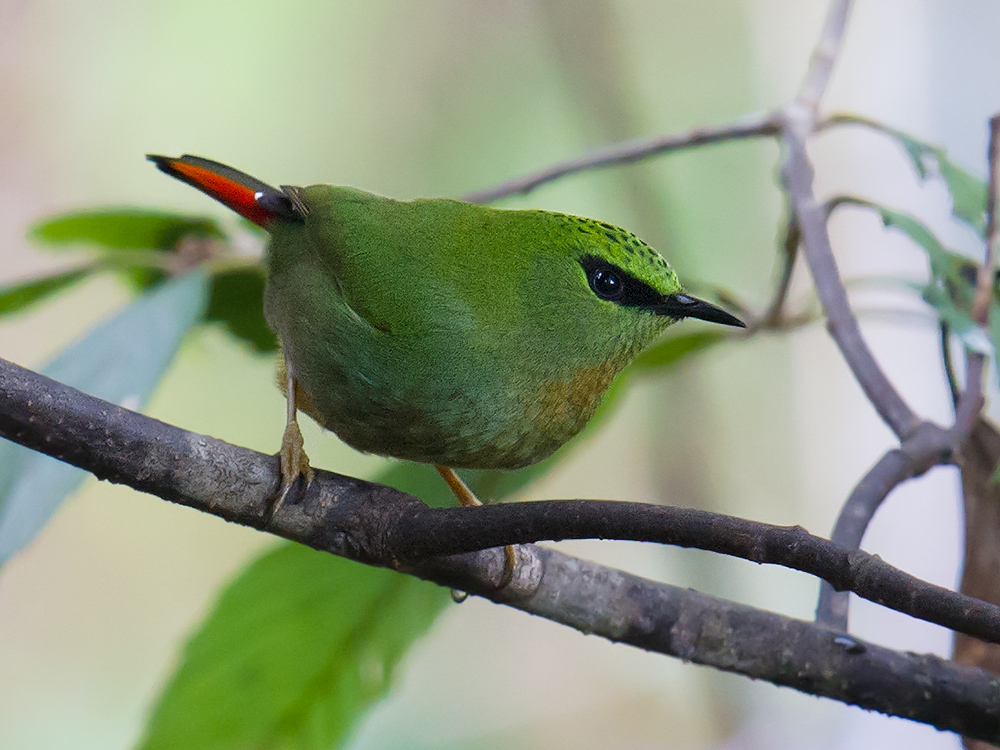
A week in Yunnan is under our belt, and Dulong Gorge is yielding amazing Himalayan specialties. Among the species noted by us so far are Fire-tailed Myzornis, Grandala, Rufous-breasted Bush Robin, Striated Laughingthrush, and Assam Laughingthrush as well as Gongshan Muntjac. We have noted western Yunnan favorites Rusty-flanked Treecreeper, Yellow-throated Fulvetta, Beautiful Sibia, Rusty-fronted Barwing, and Streak-throated Barwing. We have heard the mournful whistle of Hill Partridge, found a flock of 140 Tibetan Serin, noted Goldcrest in a mixed flock at 2960 m (9,710 ft.), and discovered 4 Eurasian Teal looking out of place on the Dulong River. Also using the river are Common Merganser, Great Cormorant, Crested Kingfisher, and Brown Dipper. Crimson-breasted Woodpecker was a lifer for us, and Wallcreeper delighted us all. We noted a troop of Stump-tailed Macaque.
HOW WE GOT TO DULONG GORGE
To reach this remote valley, on Tues. 16 Feb. My wife Elaine Du, our partner Brian Ivon Jones, and I drove non-stop from Kunming Changshui International Airport (25.101330, 102.934924) to Gongshan (27.741232, 98.665604), a grueling ride of 12½ hours and 814 km (506 mi.). Brian, an Englishman living in Shenzhen, is the person who first gave me the idea of visiting the Dulong Gorge; this is my fourth birding trip with him. From Kunming we took the G56 to the G320 and S228 north of Baoshan. We drove the narrow S228 at night because we guessed that traffic in the dozens of towns along the Salween River would be less. We were right. At 03:15 Wednesday we arrived exhausted but in good spirits at Gongshan.
On Wednesday morning 17 Feb., we stocked up on food and fuel at Gongshan. We filled the tank of our rented Mitsubishi Pajero and, after applying for a permit with the local government, filled a 30-liter (7.9 U.S. gal.) tank with gasoline. The tank would hold our extra source of fuel, for there are no service stations in the Dulong Gorge.

We birded the Gongshan–Dulong Road 87 km (54 mi.) to Kongdang (27.874454, 98.336630). On the Gongshan side, still in the Salween basin, we noted our first of many Ashy-throated Warbler, Yellow-browed Tit, Whiskered Yuhina, Stripe-throated Yuhina, Fire-breasted Flowerpecker, and Green-tailed Sunbird. A bird wave at elev. 1980 m (6,500 ft.) gave us views of less-common birds such as Black-eared Shrike-babbler, Grey Crested Tit, and Blyth’s Leaf Warbler. At a scenic overlook at 2450 m (8,040 ft.), we found a stunning male Blue-fronted Redstart. At about 2600 m (8,530 ft.), we began to notice snow on the ground. At 2960 m (9,710 ft.), near the eastern terminus of the Dulongjiang Tunnel, with snow lying deep all around us, a bird wave passed. It contained Coal Tit as well as our first Rusty-flanked Treecreeper and Goldcrest.
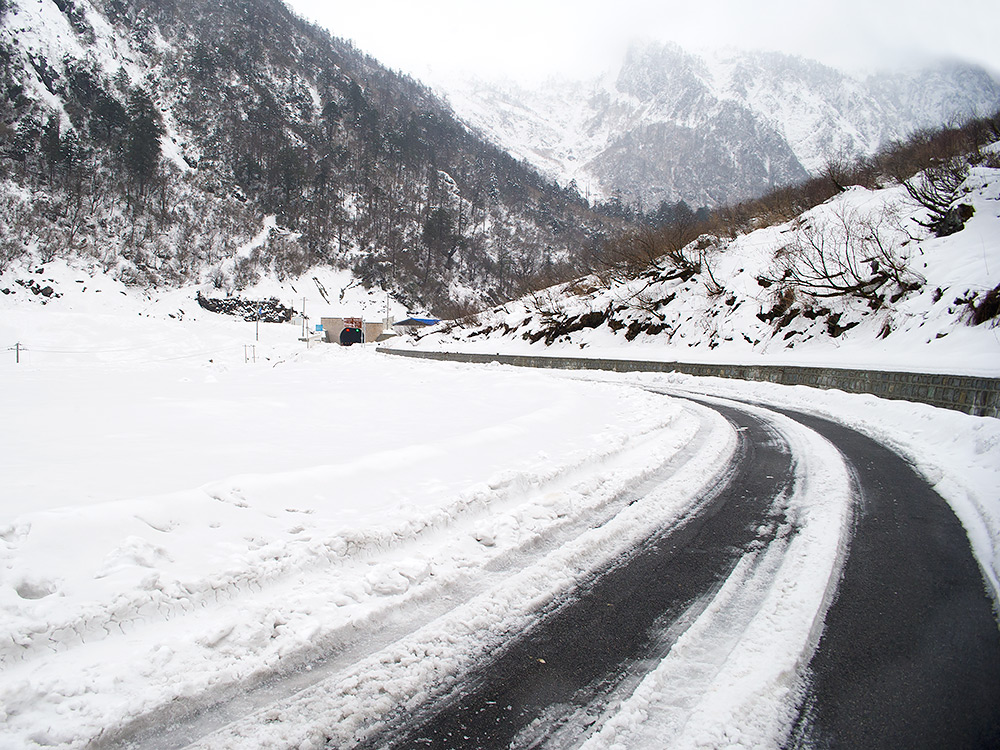
On the other side of the tunnel, at elev. 2260 m (7,420 ft.), we noted Darjeeling Woodpecker and Beautiful Sibia at a stretch of road I call “Sibia Lane” (27.909517, 98.410674). I never fail to find Beautiful Sibia there. At the bridge below we found Yellow-browed Tit and a flock of Black-faced Warbler.
In Kongdang, the administrative center of the Dulong Gorge, I found a town much different from the one I met during my first trip here in June 2014. Bridges are being built, a row of new hotels and restaurants has arisen, and a service station is under construction. Despite the progress, this valley still feels like a land that time forgot. Some Dulong people keep the tradition of animal sacrifice, and we have seen two old women with tattooed faces.
DULONG GORGE FROM END TO END
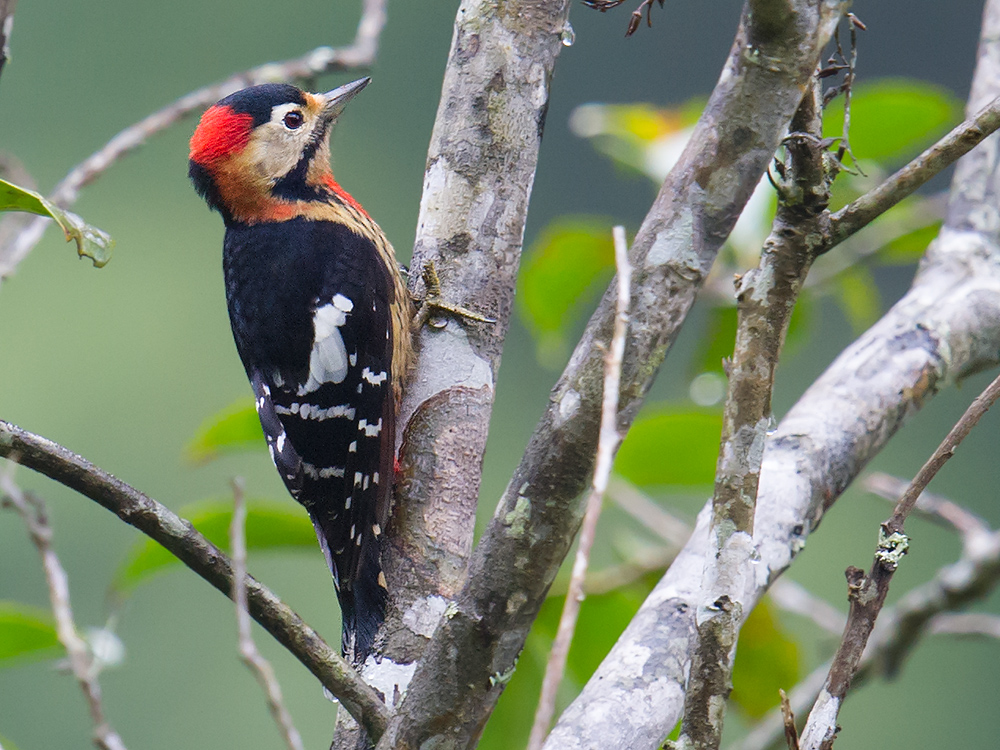
We spent Thursday, Friday, and Saturday exploring the areas south, north, and east of Kongdang (27.874454, 98.336630). On Thurs. 18 Feb. we drove to Qinlangdang (27.686833, 98.283097), the village at the southern terminus of the Dulong Gorge road and the last stop before the China-Burma border. We noted 45 species and covered elevations ranging from 1220 m (4,000 ft.) at Qinlangdang to 1570 m (5,150 ft.) along the cliffs north of that village. Great Cormorant and Crested Kingfisher were a surprise. An impressive bird wave just south of town netted us many trip firsts, among them Crimson-breasted Woodpecker, Rufous-bellied Niltava, and Silver-eared Mesia. At stops along the road we found Rufous-breasted Bush Robin, a lifer for all of us, as well as Golden-throated Barbet, Black-faced Laughingthrush, Rusty-fronted Barwing, and Alpine Accentor.
On Fri. 19 Feb. we headed north. We easily found Wallcreeper, and in the heavily forested opposite bank of the river we heard the harsh cries of Striated Laughingthrush. As we drove, we scanned the river carefully, particularly the calm spots. At one such spot we found 4 Eurasian Teal. They were not feeding and must have been using the gorge as a conduit to more suitable waters. South of Xiongdang (28.106766, 98.322952), conifers and other alpine flora begin to predominate, and the landscape looks profoundly different from the lusher, warmer areas around Qinlangdang. We found a scree slope far above us and, using my spotting scope, I pulled in a flock of 8 Grandala.
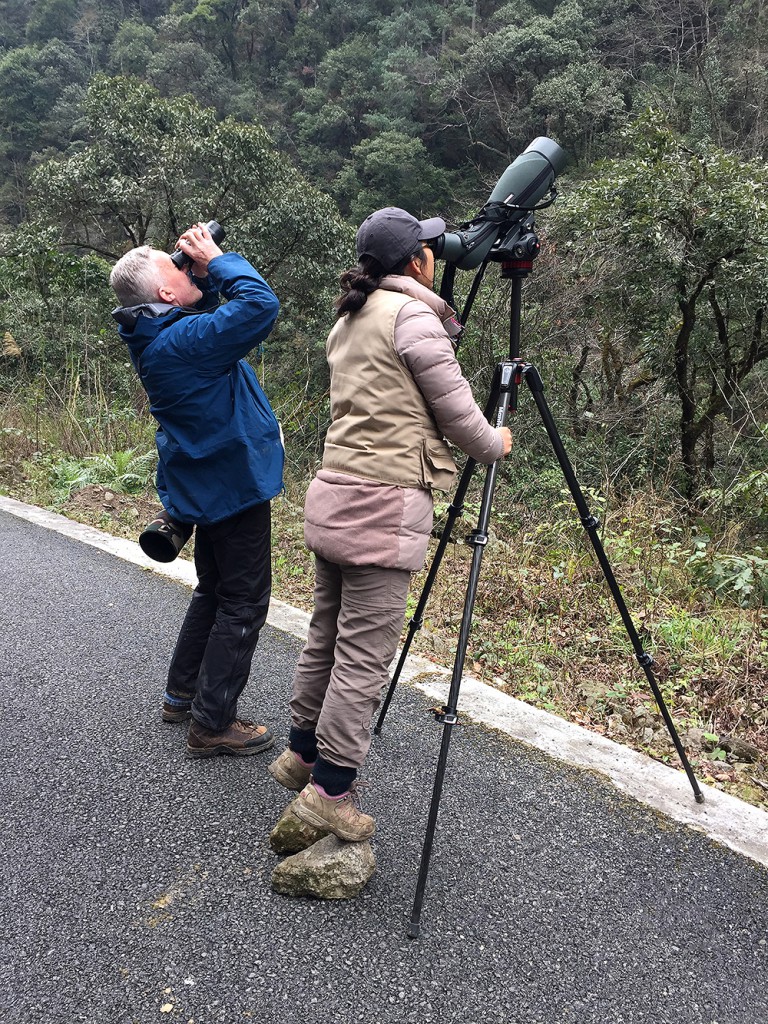
Dizhengdang (28.079174, 98.325987) occupies one of the broadest areas we have seen in the Dulong Gorge and is an excellent place for birding. At the fringes of the farmland are scrubby areas that hold many species and will surely hold more come spring, and there is a collection of abandoned farmhouses and adjacent gardens that will be nicely overgrown a few months from now. We finally were able to leave the car here and walk around. We picked up many trip firsts, among them Himalayan Buzzard, Snow Pigeon, Grey-backed Shrike, Black-browed Bushtit, and White-throated Redstart. We drove north to the village of Xiongdang. We drove past the church in Xiongdang on a dirt road that is soon to be a paved highway to Tibet. We stopped 3 km (2 mi.) north of the village. As it was late afternoon and because the road was getting rougher, we decided to turn back. We noted Common Merganser and Brown Dipper, and as we approached Xiongdang again we encountered another Wallcreeper.
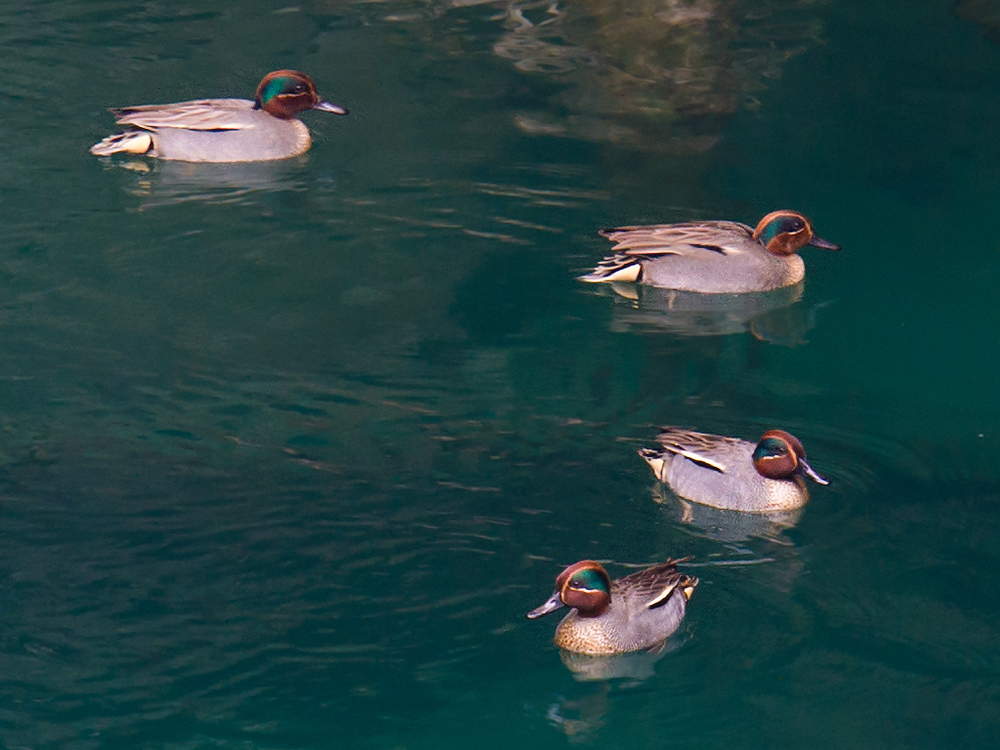
Sat. 20 Feb. saw us head back up the Gongshan–Dulong Road. We birded an elevation range of 1350 m (4,430 ft.), from 1490 m (4,890 ft.) in Kongdang (27.874454, 98.336630) to 2840 m (9,320 ft.) at the snowy western terminus of the Dulongjiang Tunnel. Elaine saw a bird that had to be either Ward’s or Red-headed Trogon, and we heard the cries of Hill Partridge on the ridges above us. At Sibia Lane (27.909517, 98.410674), elev. 2260 m (7,420 ft.), Elaine cried out, “Myzornis!” Brian and I came running and found a pair of this quintessential Himalayan bird. The pair gave us clear views before retiring into the undergrowth, and we found another pair nearby. The beautiful, emerald-green cross between parrotbill and babbler was a lifer for Elaine and Brian. I had seen the species in 2014.
Striated Laughingthrush and Assam Laughingthrush were hard-won ticks. A flock of 4 of the former appeared screaming above us on the Gongshan–Dulong Road. The fig tree on which they were feeding was directly above us, 25 m (82 ft.) high. I leaned back and took record shots, set down my camera, and recorded the harsh cries before a car came and forced me to pause. Later, examining the photos and listening carefully to my recording, we were able to get the ID. Here is the recording I made of Striated Laughingthrush (00:08; 1.1 MB):
The Assam was almost as tricky. Walking along the road, I scared off a single laughingthrush. As Black-faced Laughingthrush has been the most commonly seen laugher so far, I played back a recording of that species to see whether I would get a response. The Assam called back from cover. It was obviously not a Black-faced, but what was it? The bird alighted very briefly on a backlit branch, a silhouette against the sky; this allowed me to determine its size and nothing more. But I had recorded the call, and comparisons to Assam recordings I have downloaded from xeno-canto.org allowed me to make the ID. Here is my recording of the brief call (00:03; 905 KB):
On Sun. 21 Feb. it rained all day and we did no birding. In Kongdang electricity was out for most of the day, and even the cell-phone signal died. We took advantage of the down time to sleep.
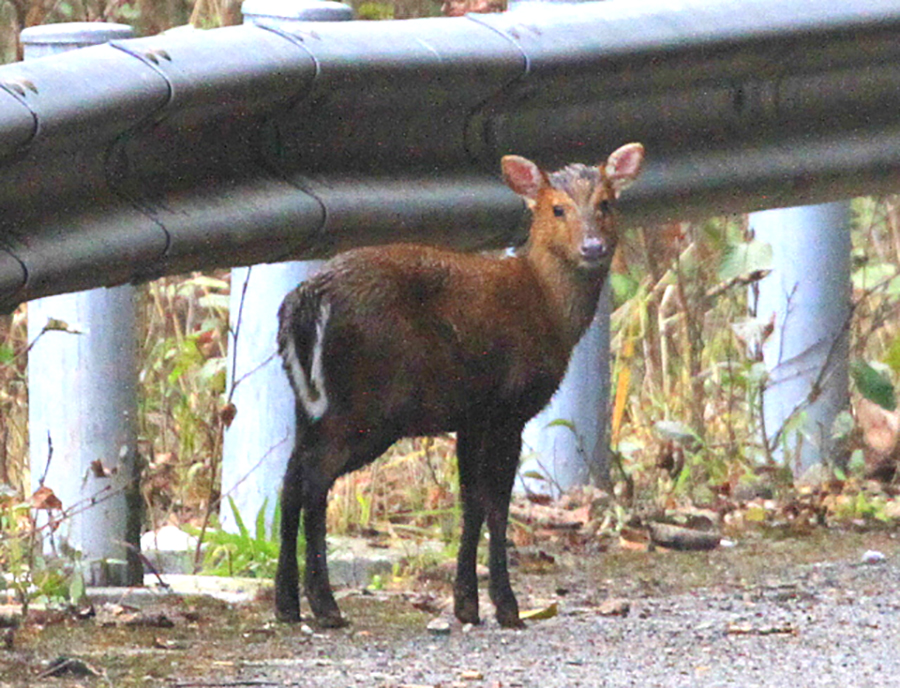
Mon. 22 Feb. saw us redo our route to the Dulongjiang Tunnel and back. The big find of the day was the mysterious Gongshan Muntjac. We were at the large clearing at 2300 m (7,550 ft.) on the Gongshan–Dulong Road. I had just recorded a lively pair of Bay Woodpecker and was walking back toward the car and Brian. My partner was looking at a dark spot below us on the road. Brian and I aimed to shoot, and I found to my horror that the ultra-high humidity of the gorge had compromised the focusing mechanism on my lens. I had to focus manually, and by that time the muntjac had turned its back to us. Brian captured the earlier moment when the deer was still looking back at us. The diminutive, rare deer scurried under the guardrail to cover. We walked downhill to the point where it had stood. Above us, we heard a sound like a man imitating a dog barking. Muntjacs are also known as “barking deer”; now we knew why. We believe we photographed a doe and that the buck was barking from cover. So little is known about Muntiacus gongshanensis that IUCN lists it not as endangered or near threatened but as “data deficient.” Almost all photos taken of the species have been done by camera traps. We have photos of an animal that we saw. I recorded the barking:
Gongshan Muntjac Muntiacus gongshanensis, barking twice during a rain shower, Dulong Gorge, Yunnan, China, elev. 2300 m (7,550 ft.), February, by Craig Brelsford (0:19; 1 MB)
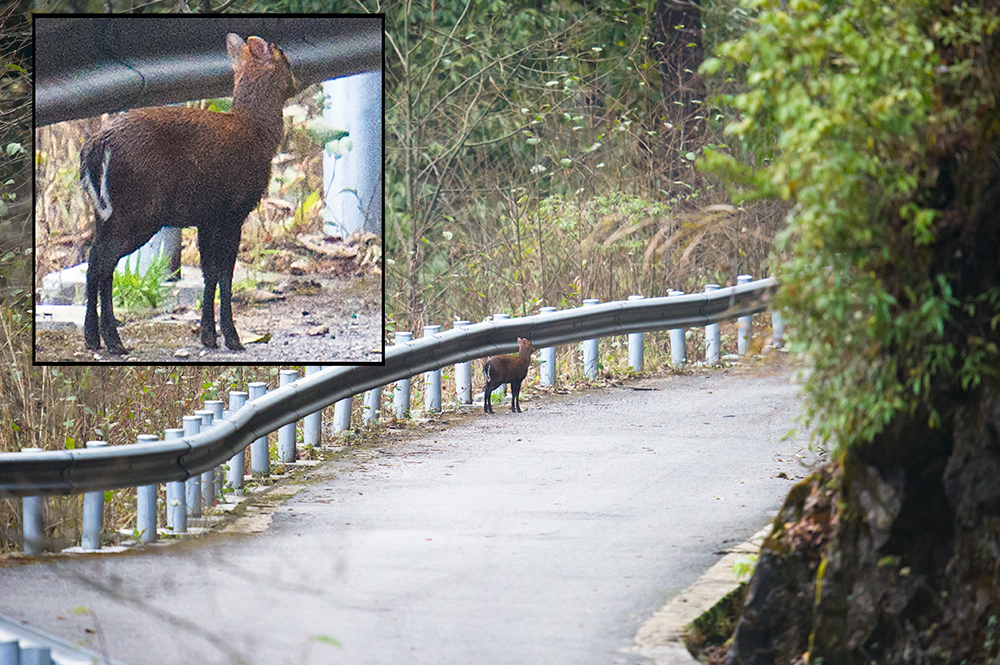
The other mammalian highlight was Stump-tailed Macaque. Walking along the road, I noticed rustling in the bamboo far down slope. At first I thought I had startled a herd of small deer. I got this impression because the animals were on the ground and were on all fours. I was able to determine that the animals were macaques. I noted a bare face and nub of a tail. We estimate the troop contained about 10 individuals.
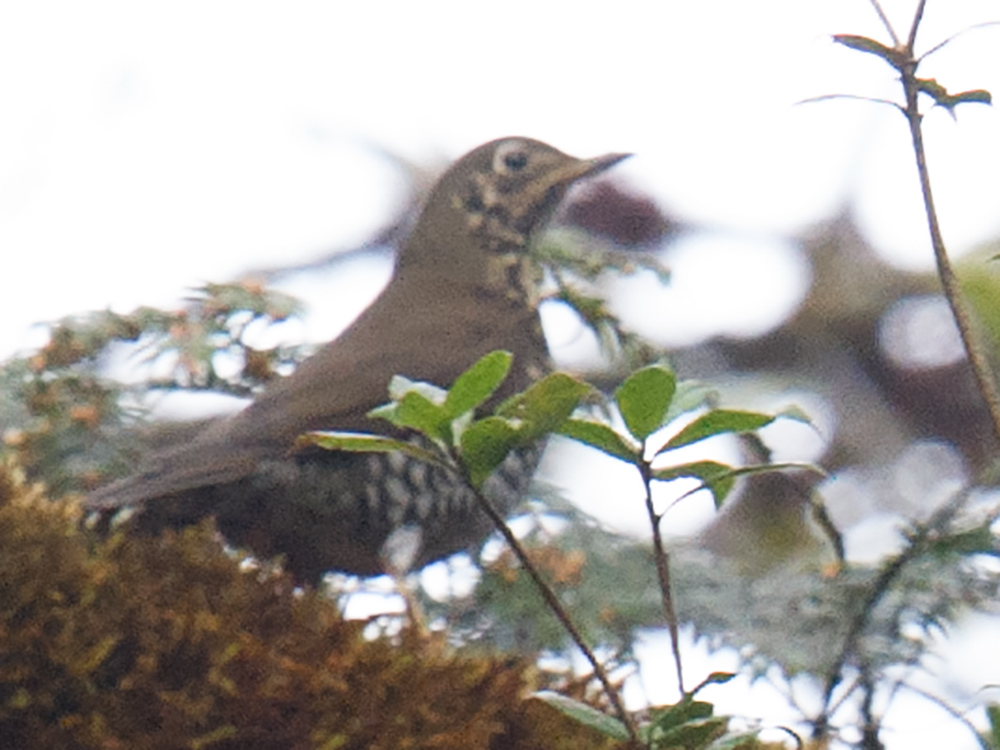
Amid these glories, the birding was not bad! We added these species to the trip list: Rufous-bellied Woodpecker, Bar-throated Minla, Golden-breasted Fulvetta, White-browed Fulvetta, Himalayan Bluetail, Rufous-breasted Accentor, and the recently re-described Alpine/“Yunnan” Thrush. Elaine, who is familiar with the Zoothera thrushes because of my keen interest in this genus, radioed me: “Himalayan Thrush!” I ran back and just managed to capture record shots. The bird I photographed has the dark ear coverts, yellow base of lower mandible, and yellow legs that distinguish Alpine/“Yunnan” Thrush from Himalayan Thrush.
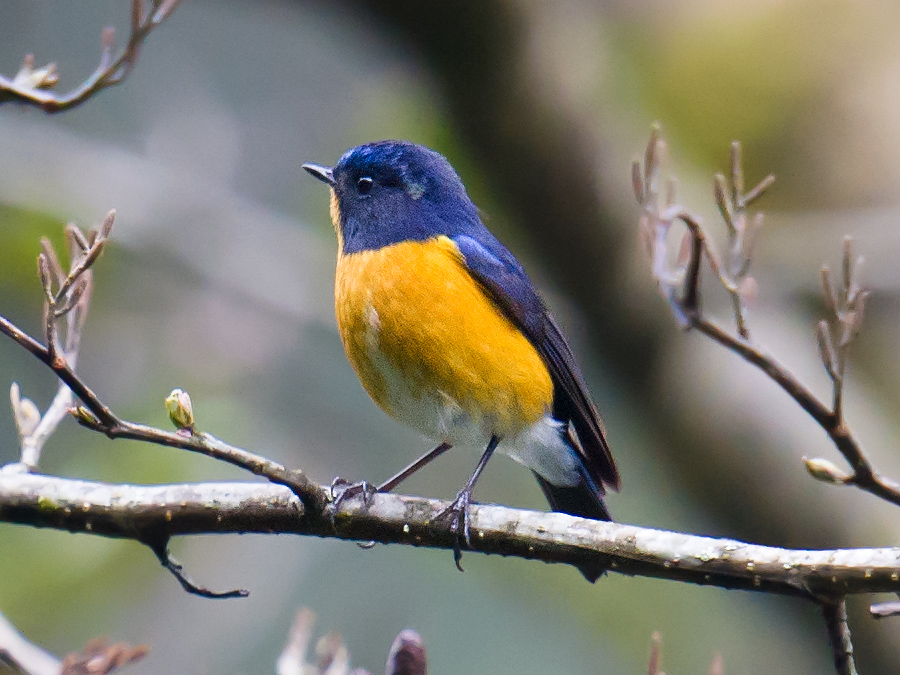
Other big news: 290 Grandala in two flocks, an impressive 168 Tibetan Serin, a Fire-tailed Myzornis whose loud calls caused us to stop the car to look, and yet more encounters with Rusty-flanked Treecreeper and Rufous-breasted Bush Robin.
Tues. 23 Feb.–Thurs. 3 March Kongdang (27.874454, 98.336630)
Fri. 4 March Wayaozhen (25.445260, 99.263076)
Sat. 5 March Kunming
The second half of our Dulong trip lasted 13 days, from 23 Feb. to 6 March. Brian Ivon Jones, my wife Elaine Du, and I saw drier weather and a rich procession of birds, taking our species count to 170. We found Golden-naped Finch at bird-rich Sibia Lane (27.909517, 98.410674), we noted Fire-tailed Myzornis at various locations, we marveled at Ibisbill on the Dulong River, and we witnessed a spectacular flock of 300 Grandala. With the clearing of mudslides that had blocked access to the southern end of the gorge, we spent five days around Qinlangdang. There, Brian noted Beautiful Nuthatch, and we found Coral-billed Scimitar Babbler, Red-billed Scimitar Babbler, Himalayan Cutia, and Scaly-breasted Cupwing. Driving and walking along the twisting roads, we noted Black-headed Shrike-babbler, Gould’s Shortwing, Long-billed Wren-Babbler, Rusty-flanked Treecreeper, and the newly described Himalayan Thrush and Alpine/“Yunnan” Thrush. Rufous-breasted Bush Robin made several appearances at various elevations, Himalayan Bluetail was noted in smaller numbers, and White-naped Yuhina and Yellow-throated Fulvetta often were in large flocks. Heading back to Kunming, we found Banded Bay Cuckoo near Wayaozhen.
RAIN, RAIN, RAIN … AND A REPRIEVE
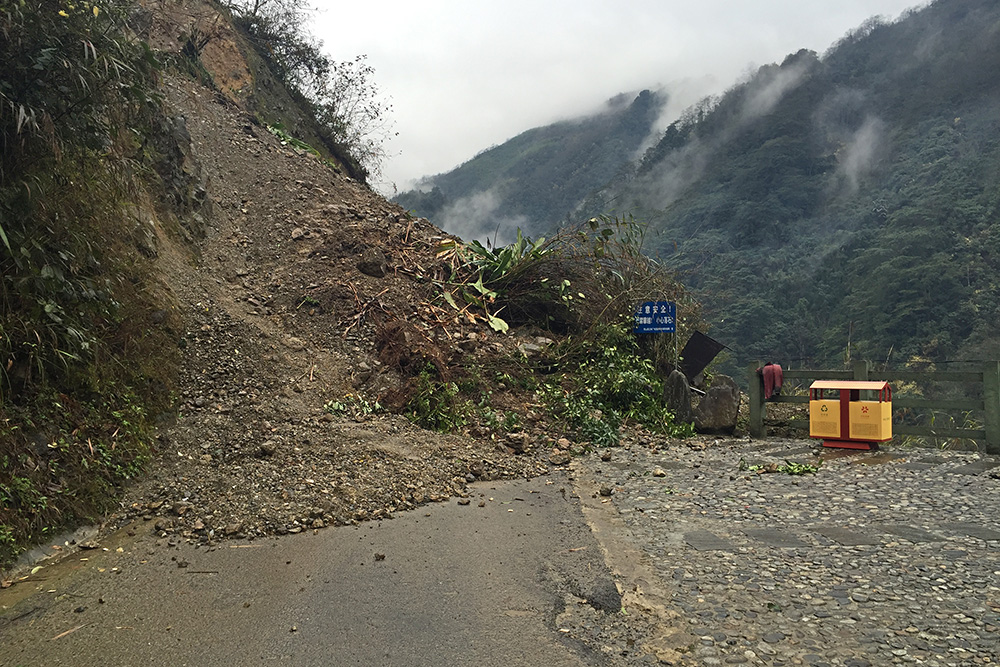
The rain from the first week of the trip was still with us on Tues. 23 Feb. and Wed. 24 Feb., causing a mudslide near Bapo (27.737042, 98.350309) that blocked access to Qinlangdang. Even on Thurs. 25 Feb., skies were still grey, and despite the excellent weather on Fri. 26 Feb., the road to Qinlangdang was still blocked. We grit our teeth and birded on.
23 Feb. saw us note just 28 species, but among them were choice birds such as Black-headed Shrike-babbler, Golden-naped Finch, Blue-winged Laughingthrush, and Dark-rumped Rosefinch. We found Golden-naped Finch, the rosefinches, a few of our Fire-tailed Myzornis, and White-browed Fulvetta around Sibia Lane (27.909517, 98.410674). This bird-rich spot on the Gongshan–Dulong Road has tall trees, rich undergrowth, and many birds, among them the Beautiful Sibia which are a constant presence there and for which the place is named.
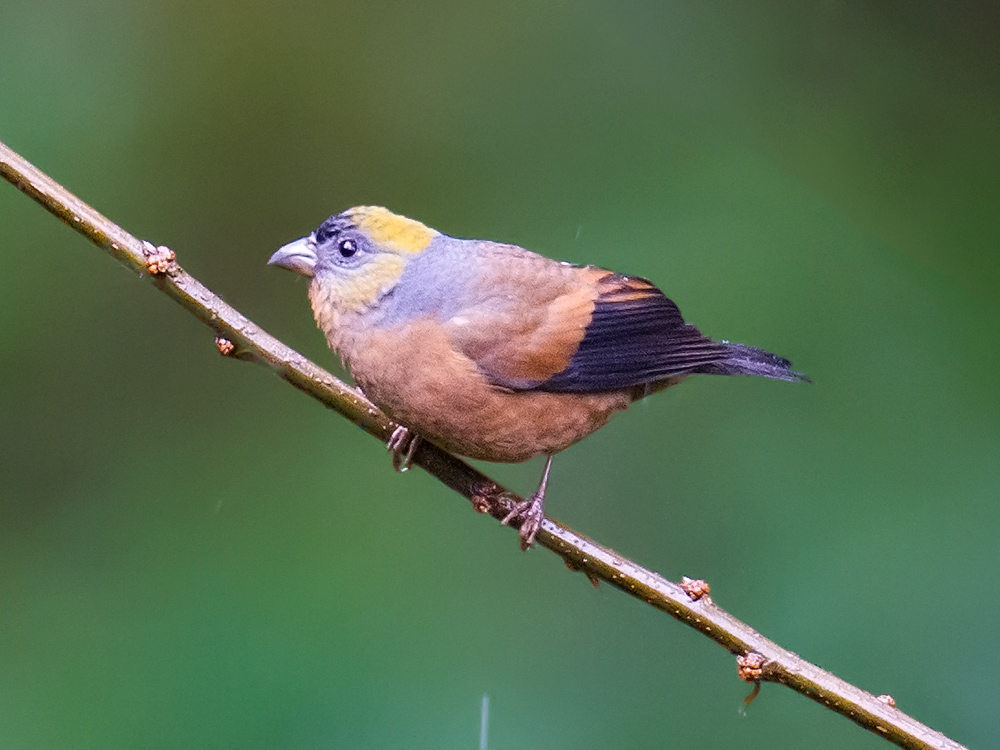
On 24 Feb. we noted 51 species despite the rain and despite doing all our birding within 12.5 km (7.8 mi.) of Kongdang (27.874454, 98.336630), our home base. One reason for our success was my re-discovery of Dulong Beach (27.795076, 98.329884), a place I remembered from my 2014 visit and one of the few broad areas in that part of the Dulong Gorge. At Dulong Beach, one can park in a spacious parking area well off the narrow road, and it is possible to walk around. Great Cormorant roost on boulders studding the Dulong River, and occasionally a Mallard flies by; Himalayan Swiftlet can be seen in the corridor of sky framed by the gorge; Ashy Drongo and Striated Bulbul hawk insects high in the trees; White-naped Yuhina and Grey-cheeked Warbler browse in the trees; Golden Babbler join bird waves with Yellow-browed Tit, Rufous-capped Babbler, and Yellow-throated Fulvetta; and Chestnut-headed Tesia, Slaty-bellied Tesia, and Pygmy Cupwing call from the undergrowth.
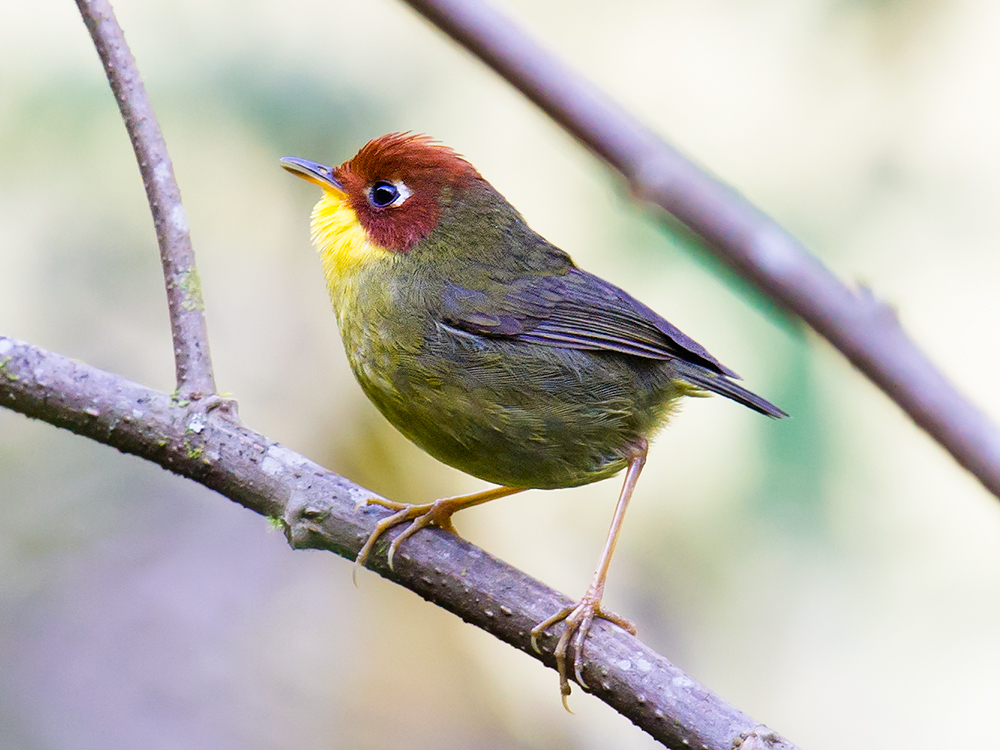
We also birded an even broader area, Pukawang (27.842608, 98.327274), the resort 8 km (5 mi.) north of Dulong Beach and 4.5 km (2.8 mi.) south of Kongdang (27.874454, 98.336630). There we found Rufous-breasted Bush Robin, Large Niltava, Rufous-breasted Accentor, and Little Bunting using the now-barren gardens and fields. Little Forktail was in the Dandangwang River. We found Elliot’s Laughingthrush.
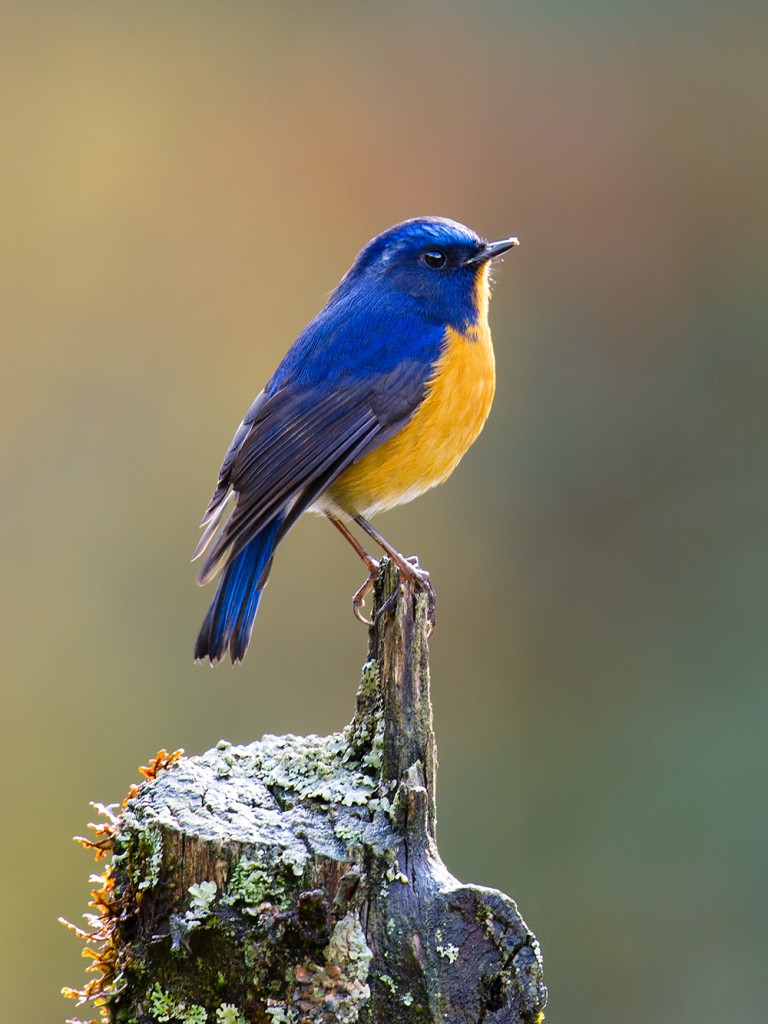
25 Feb. saw us stymied in our quest for Qinlangdang by a mudslide at Bapo. We retraced our steps to Dulong Beach (27.795076, 98.329884), where in a bird wave we found Black-throated Parrotbill. We had our first record of Grey-chinned Minivet, and at Pukawang we had our only record of Pied Bush Chat and only Dulong record of Eurasian Hoopoe. The next day saw splendid blue skies, but the still-blocked road meant we had to work the Gongshan–Dulong Road once again. There, we achieved stunning photos of the moon setting over the mountains, fresh with new snow. In the afternoon, we returned to Dulong Beach, where Brian spotted Black-crested Bulbul high on the ridge on the opposite side of the river.
RETURN TO QINLANGDANG
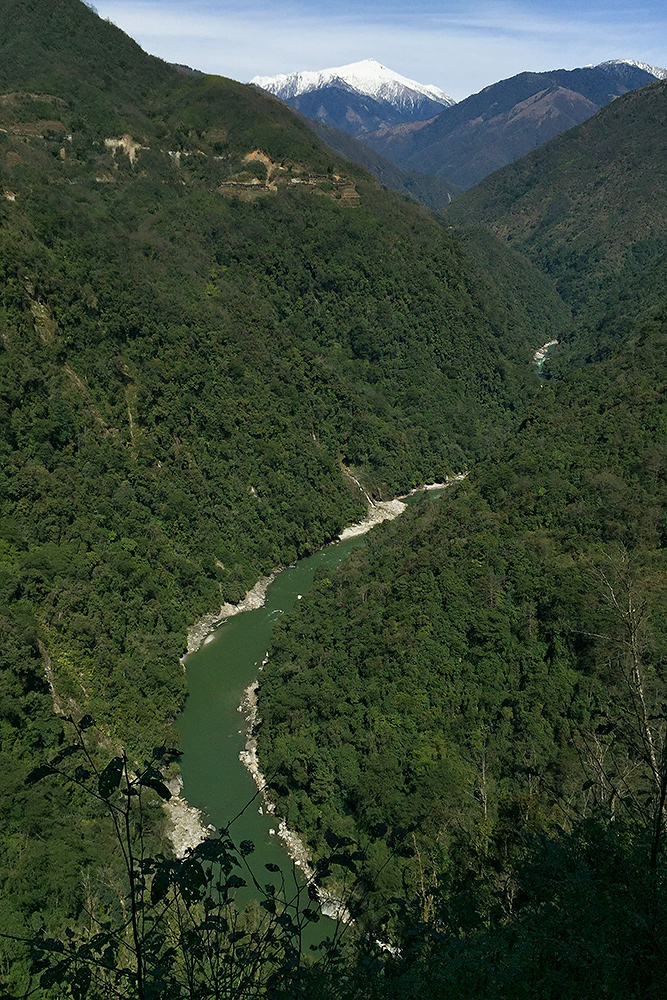
Once the weather improved and the road crews cleared the road, we headed straight for Qinlangdang and the southern end of the gorge. We spent five of the next six days here: Sat. 27 Feb. through Mon. 29 Feb. and Wed. and Thurs. 2–3 March.
On 27 Feb., during the 43 km (27 mi.) drive from Kongdang (27.874454, 98.336630) to Qinlangdang, we stopped at Dulong Beach (27.795076, 98.329884). There we met Ān Kǎi Xiáng (安凯祥, “Steven An”), a tour guide whom I have met on several occasions, and Hóu Tǐ Guó (侯体国), the man famous for running the photo blinds at Baihualing. They were guiding Erik and Henning, two Danes and friends of Jesper Hornskov’s. Erik and Henning paid this writer a nice compliment: They had read my post on Week 1 of the Dulong trip! We chatted awhile and admired a Rufous-gorgeted Flycatcher. Also at Dulong Beach, we saw Crested Kingfisher flying rapidly up the river and found Scaly Laughingthrush.
Further down, we yet again heard Long-billed Wren-Babbler calling from thick undergrowth on the side of the road; try as I might, I could not coax the bird out, but I recorded its call (0:03; 922 KB):
Driving back, nearing dark we got a lifer for Brian and Elaine: Rufous-backed Sibia. I captured sound and an image of this impressive bird (0:35; 2.2 MB):
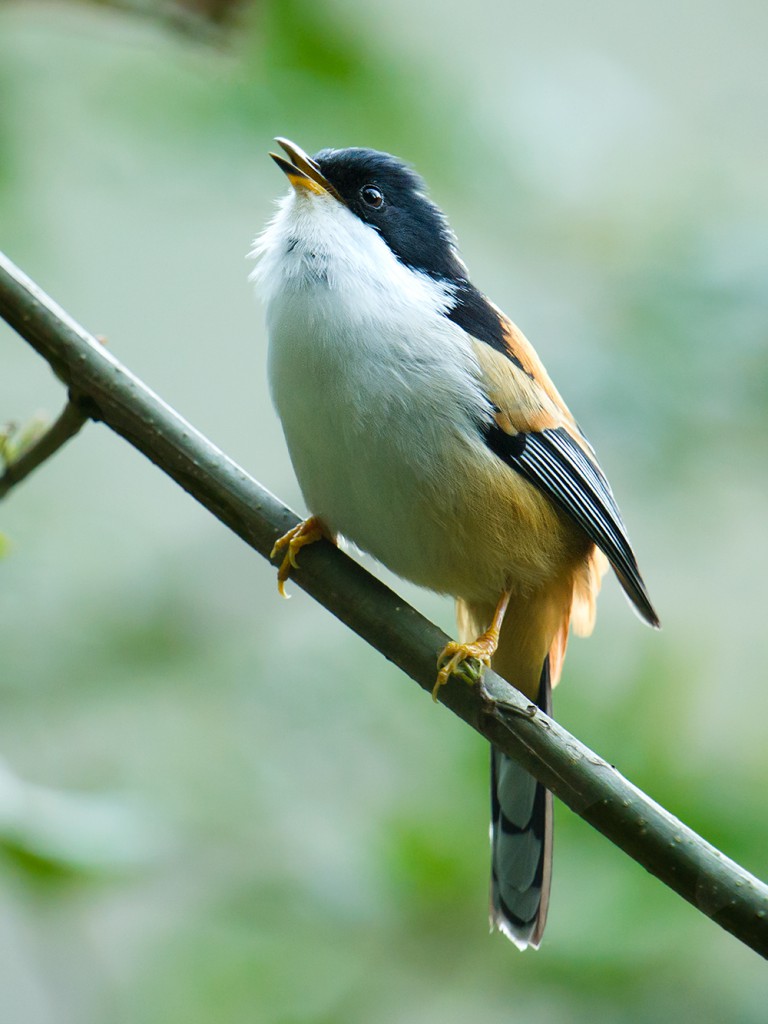
On the morning of 28 Feb., again near Qinlangdang, and after hours spent searching for Beautiful Nuthatch with no success, I heard dueling Spotted Elachura singing from either side of the Dulong River. Dilemma: (1) Study elachura, a sure thing, or (2) invest still more time in searching for Beaut Nut? Brian opted for Choice 2 and walked ahead. Elaine and I chose Option 1 and achieved an excellent recording of the strange song of Spotted Elachura plus my closest views ever of the species. Here is what I captured (1:17; 3.9 MB):
Brian, meanwhile, found Beaut Nut! He radioed us, but we arrived too late. Congrats, Brian! We also got Himalayan Cutia, a lifer for Brian.
Other great birds from 28 Feb.: Black-headed Shrike-babbler and Blyth’s Shrike-babbler, another encounter with that Long-billed Wren-Babbler on the side of the road, Scaly-breasted Cupwing, good views of Striated Laughingthrush, and new looks at Blue-winged Laughingthrush and Scaly Laughingthrush. We found 4 Zoothera birds, most likely Alpine/“Yunnan”/Himalayan Thrush, feeding along the pre-dawn road and looking like nightjars (Brian’s apt description) as they fled our car.
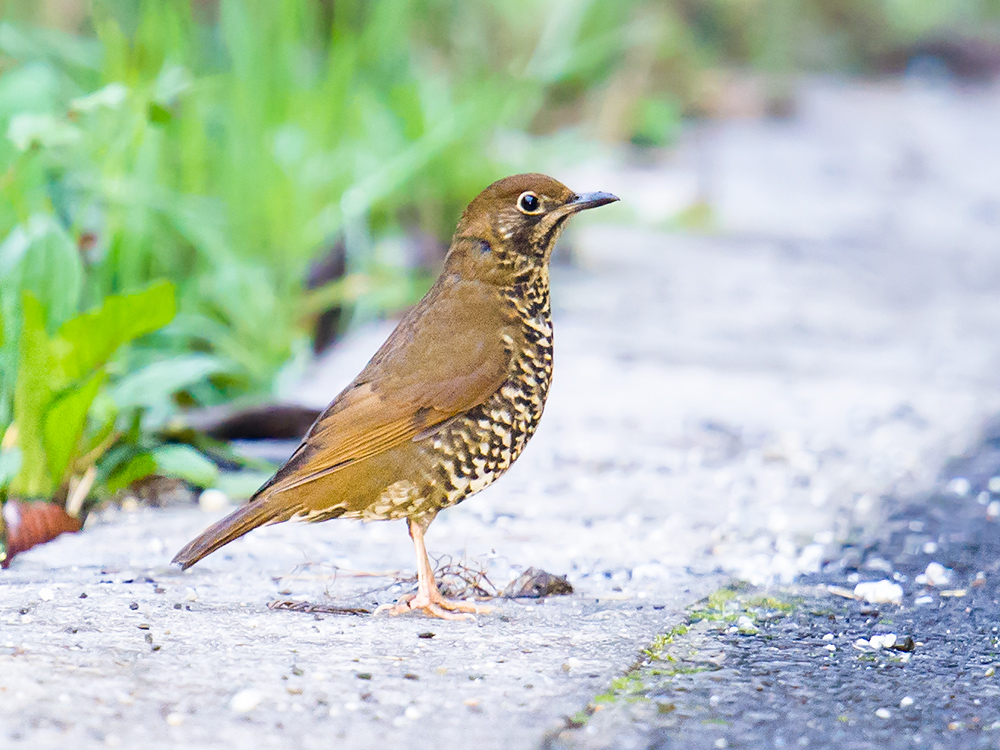
29 Feb. saw us once again working the area around Qinlangdang. The terraced fields at the north entrance to the village are a good place for birds, yielding our only Dulong records of Hill Prinia, Slaty-backed Forktail, and Black Redstart as well as Blue-fronted Redstart and Olive-backed Pipit. At Brian’s nuthatch spot just north of town, relaxing in our parked car I got our only owl record of the trip: Asian Barred Owlet, calling unseen from the ravine on the opposite side of the river. In the morning, as we were driving to Qinlangdang we heard Brown-flanked Bush Warbler singing at Maku and at another place farther south.

On 1 March we changed direction, heading north 31 km (19 mi.) on the paved road to Dizhengdang. There, we revisited the extensive farmland north of town. Within a large flock of Little Bunting, Elaine and I picked out 3 Godlewski’s Bunting. Blue-winged Laughingthrush were using trees between two abandoned farmhouses, and we found Snow Pigeon and a smart male Hodgson’s Redstart. Brian went off on his own, finding White-throated Dipper. We drove through Xiongdang to the road being constructed north of that village. We took it to a point 9 km (5.6 mi.) north of town, where a rockslide stopped us. Here we noted Mountain Hawk-Eagle.
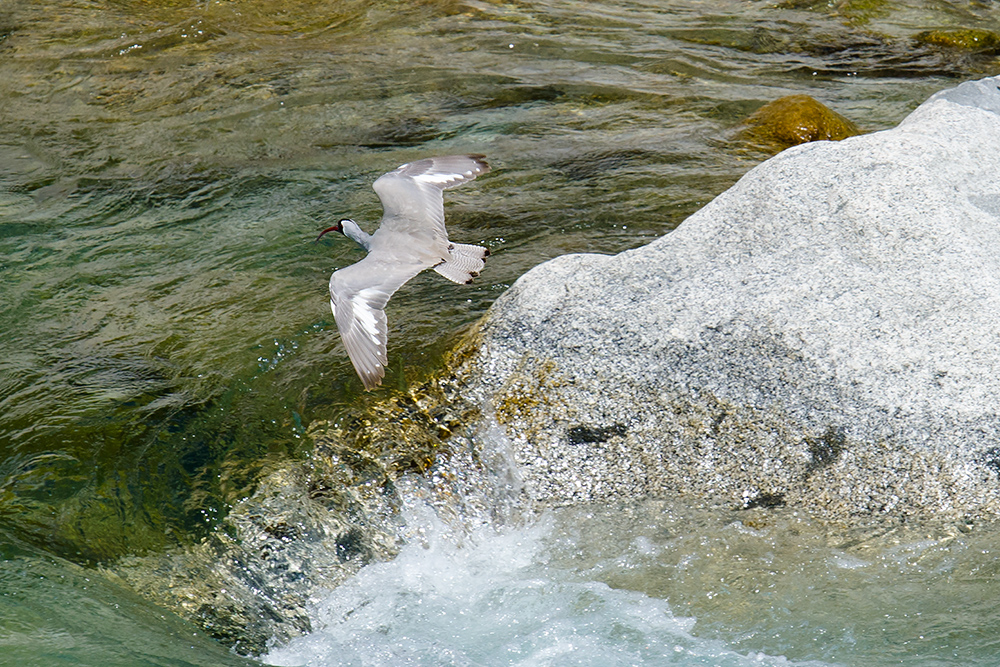
Heading back, just north of Xiongdang, Brian, once again walking ahead, radioed us: “Ibisbill, flying downstream!” Brian deserves credit for insisting that this most unusual of waders would be on the Dulong. “The habitat is right; they must be here,” he had said repeatedly. Now Brian had his reward, but what about Elaine and me? Would it be possible for us to get a view? It was up to me to guess where the Ibisbill had flown to. Zipping past Brian’s position, Elaine and I sped south in the Pajero, splashing through a creek along the way. We approached the church in Xiongdang, and I said, “Let’s try here.” Elaine and I got out and, lo, there were 4 Ibisbill along the rumbling stream below. Brian arrived, and we savored the view together.
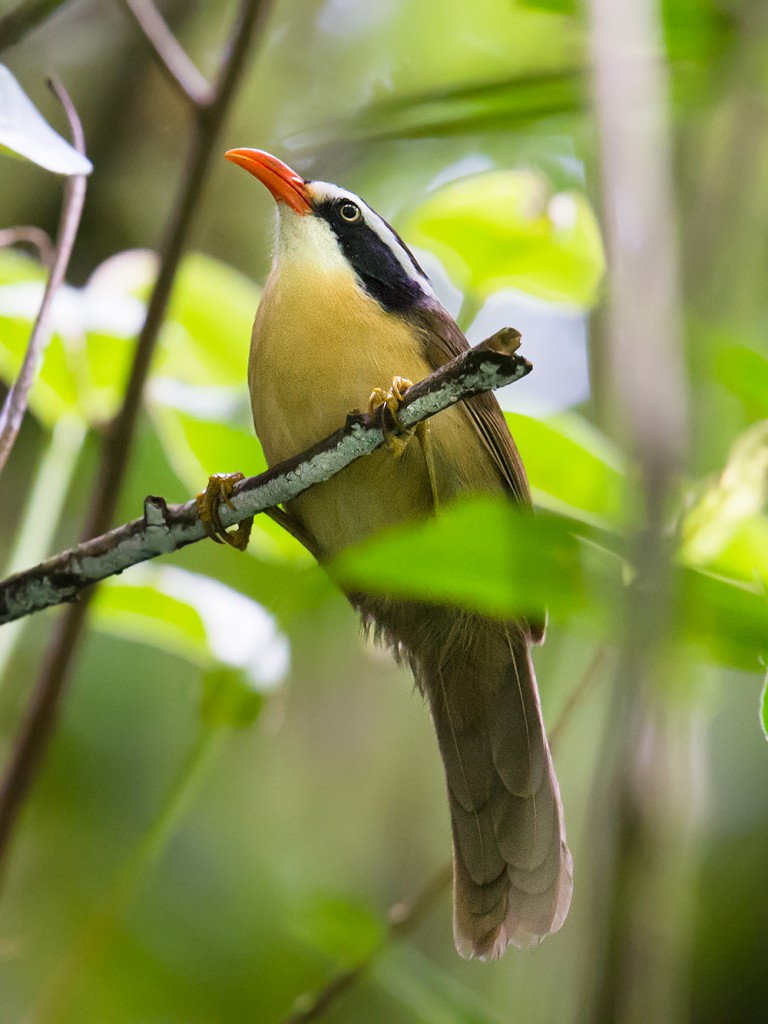
On our two final full days in the gorge, 2-3 March, we dove back into the Qinlangdang area. We met Himalayan Thrush and Alpine/“Yunnan” Thrush on the road, we had a strange encounter with an apparently lost Northern Lapwing, and we added to our trip list Coral-billed Scimitar Babbler, Red-billed Scimitar Babbler, and Bar-winged Flycatcher-shrike. I achieved an excellent recording of the powerful song of tiny Scaly-breasted Cupwing (0:24; 1.7 MB):
We found several common birds that we had not noted before, among them Japanese Tit, Chestnut-crowned Warbler, White-bellied Erpornis, and Chestnut Thrush. These late additions are an indication of the vastness of the forests and the long time it takes to get an accurate impression of the avifauna of this rich gorge.
BACK TO KUNMING
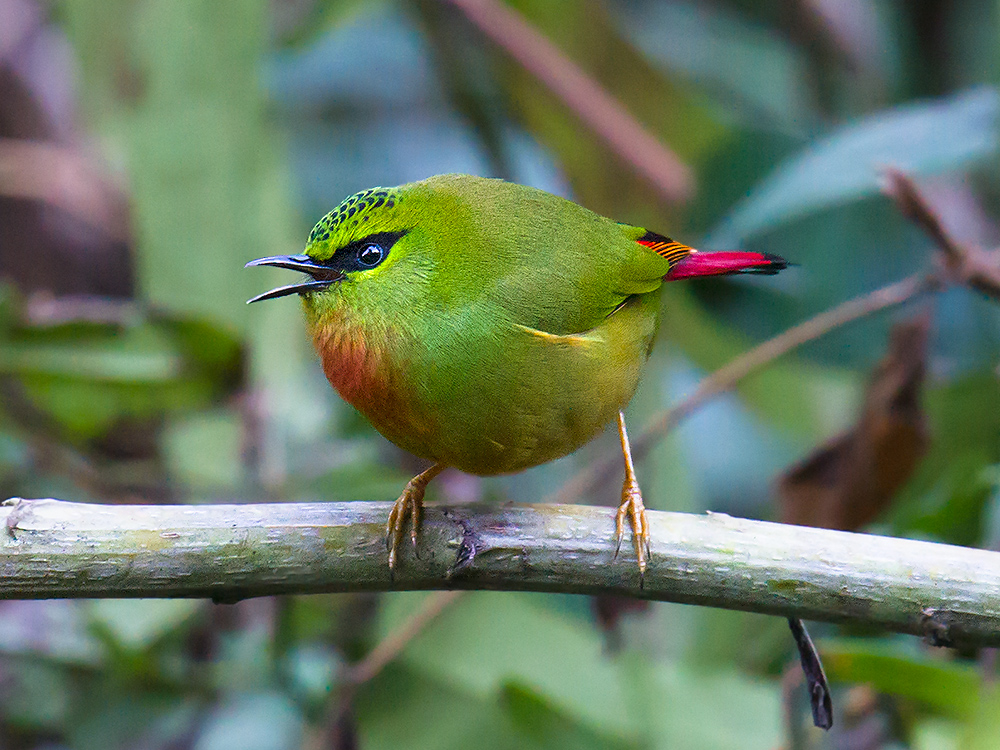
We took two full days to cover the 900 km (560 mi.) between Kongdang (27.874454, 98.336630) and Kunming. On Fri. 4 March we spent the daylight hours driving the 90 km (56 mi.) to Gongshan (27.741232, 98.665604). We saw a massive flock of 300 Grandala, added Great Barbet to the trip list, heard Hill Partridge calling unseen, and noted Fire-tailed Myzornis and Golden-naped Finch. After refueling, we departed Gongshan at 17:15 and drove south on the S228. Along this amazing, narrow road, the lifeline for the dozens of communities along the Salween River, we saw folks taking sponge baths under the spigots along the road, saw people getting haircuts at open-air barber shops just inches from passing cars, and watched a drunken man nearly walk into the path of our car. Few roads are more interesting, or more dangerous, than the S228. Long after dark, we made it to Nujiang and pressed on, arriving exhausted at 01:15 in Wayaozhen (25.445260, 99.263076), a town just a few kilometers north of the G56 freeway. Once again, we had made it through the Salween Gorge in good time, as before by driving mainly at night when traffic is less.
New birds came to us immediately the next morning: Red-vented Bulbul and Grey-breasted Prinia in the farm-garden area just across from Bababa Hotel, Grey Wagtail in a stream running between rows of houses, and White-browed Laughingthrush and Yellow-browed Warbler on the scrubby, partly forested hillside behind the hotel.
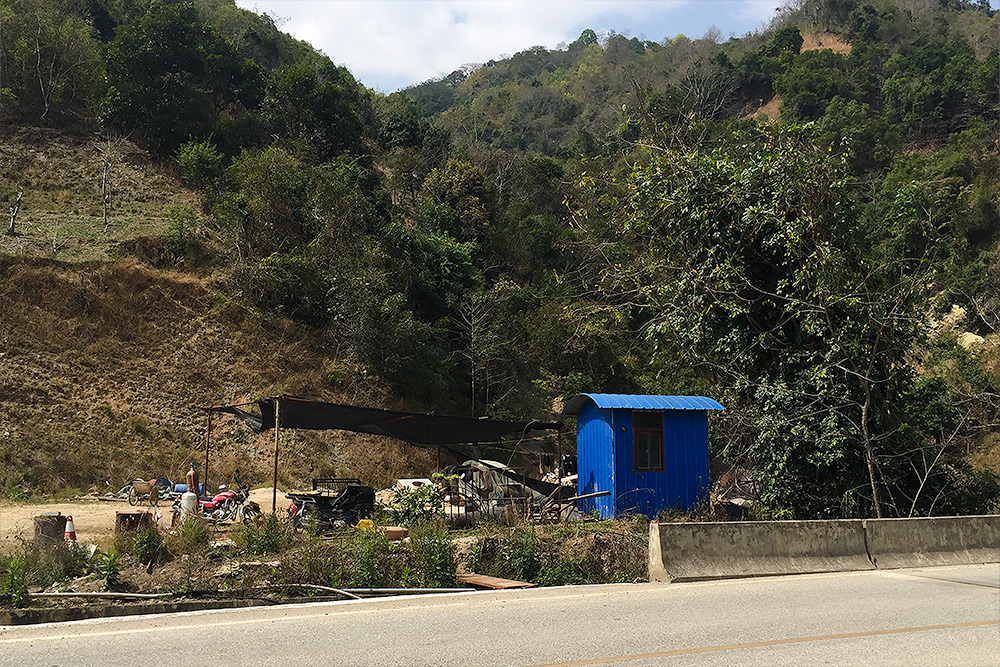
The grand finale, the fitting end to our profitable expedition, came later in the morning, less than a kilometer north of the G56. Driving on the G320 toward the freeway, I was scanning the hillside to our right and admiring the Mekong River to our left. I noticed a forested ravine (25.401533, 99.287200) that looked promising. Brian was game for a final hunt, and we set off. Elaine stayed at the car, scanning the treetops with the spotting scope. Brian and I walked up the ravine until we could walk no more, then doubled back. Along the way we heard Slaty-bellied Tesia and saw Bar-winged Flycatcher-shrike. Brian picked up Grey-throated Babbler, a species we had noted in Dulong Gorge but that Brian had not seen well.
Brian went on ahead, and I stayed behind in the forest. Suddenly a Banded Bay Cuckoo appeared on a branch just 3 m (10 ft.) from me, calling. This species is hard to find in China, has long been among my most desired of cuckoos, and was a lifer for me. I was without my camera, but I had my recorder and used it. In the recording, one notes the similarities and differences between the four-note call of Banded Bay and the well-known four-note call of Indian Cuckoo Cuculus micropterus. Whereas the call of Banded Bay is a high-pitched whistle, the call of Indian is fuller and throatier. Examine my recordings:
Banded Bay Cuckoo Cacomantis sonneratii, four-note whistle, Baoshan (25.401533, 99.287200), Yunnan, China, elev. 1290 m (4,230 ft.), 5 March, by Craig Brelsford (0:07, 1.1 MB)
Banded Bay Cuckoo Cacomantis sonneratii, rising call plus four-note whistle, Baoshan (25.401533, 99.287200), Yunnan, China, elev. 1290 m (4,230 ft.), 5 March, by Craig Brelsford (1:18, 3.9 MB)
I hustled down the hill to the car, roused Elaine and Brian, and took them up the hill. They heard the call of Banded Bay Cuckoo.
We took the G56 to Kunming Changshui International Airport, driving the last of the 2856 km (1,775 mi.) that we logged on this trip. We spent the night in the strangely named but very clean Rainbow Interstellar Hotel (+86 871-65301666). On Sun. 6 March we flew home, Brian to Shenzhen, Elaine and I to Shanghai.
Our simple list of the 170 bird species we noted is below. For the systematic list, click here.
SPECIES OF BIRD NOTED IN YUNNAN, CHINA, 16 FEB. TO 5 MARCH (170 SPECIES)
For our Systematic List, click here. Hyperlinks connect to entries in my Photographic Field Guide to the Birds of China.
Mallard Anas platyrhynchos
Eurasian Teal A. crecca
Common Merganser Mergus merganser
gamebird sp.
Hill Partridge Arborophila torqueola
Little Egret Egretta garzetta
Great Cormorant Phalacrocorax carbo
Crested Honey Buzzard Pernis ptilorhynchus
Mountain Hawk-Eagle Nisaetus nipalensis
Crested Goshawk Accipiter trivirgatus
Besra A. virgatus
Himalayan Buzzard Buteo burmanicus
Ibisbill Ibidorhyncha struthersii
Northern Lapwing Vanellus vanellus
Rock Dove (Feral Pigeon) Columba livia
Snow Pigeon C. leuconota
Oriental Turtle Dove Streptopelia orientalis
Banded Bay Cuckoo Cacomantis sonneratii
Asian Barred Owlet Glaucidium cuculoides
Himalayan Swiftlet Aerodramus brevirostris
Red-headed/Ward’s Trogon Harpactes erythrocephalus/wardi
Crested Kingfisher Megaceryle lugubris
Eurasian Hoopoe Upupa epops
Great Barbet Psilopogon virens
Golden-throated Barbet P. franklinii
Speckled Piculet Picumnus innominatus
Rufous-bellied Woodpecker Dendrocopos hyperythrus
Darjeeling Woodpecker D. darjellensis
Crimson-breasted Woodpecker Dryobates cathpharius
Bay Woodpecker Blythipicus pyrrhotis
Bar-winged Flycatcher-shrike Hemipus picatus
Grey-chinned Minivet Pericrocotus solaris
Scarlet Minivet P. speciosus
Long-tailed Shrike Lanius schach tricolor
Grey-backed Shrike L. tephronotus
White-bellied Erpornis Erpornis zantholeuca
Black-headed Shrike-babbler Pteruthius rufiventer
Blyth’s Shrike-babbler P. aeralatus
Black-eared Shrike-babbler P. melanotis
Ashy Drongo Dicrurus leucophaeus
White-throated Fantail Rhipidura albicollis
Oriental Magpie Pica serica
Large-billed Crow Corvus macrorhynchos
Yellow-bellied Fantail Chelidorhynx hypoxanthus
Yellow-browed Tit Sylviparus modestus
Rufous-vented Tit Periparus rubidiventris*
Coal Tit P. ater
Grey Crested Tit Lophophanes dichrous
Japanese Tit Parus minor
Green-backed Tit P. monticolus
Yellow-cheeked Tit Machlolophus spilonotus
Striated Bulbul Pycnonotus striatus
Black-crested Bulbul P. flaviventris
Red-whiskered Bulbul Py. jocosus
Brown-breasted Bulbul P. xanthorrhous
Red-vented Bulbul P. cafer
Mountain Bulbul Ixos mcclellandii
Black Bulbul Hypsipetes leucocephalus
Barn Swallow Hirundo rustica
Red-rumped Swallow Cecropis daurica
Scaly-breasted Cupwing Pnoepyga albiventer
Pygmy Cupwing P. pusilla
Rufous-faced Warbler Abroscopus albogularis
Black-faced Warbler A. schisticeps
Brown-flanked Bush Warbler Horornis fortipes
Slaty-bellied Tesia Tesia olivea
Chestnut-headed Tesia Cettia castaneocoronata
Black-throated Bushtit Aegithalos concinnus
Black-browed Bushtit A. bonvaloti
Ashy-throated Warbler Phylloscopus maculipennis
Yellow-browed Warbler P. inornatus
Blyth’s Leaf Warbler P. reguloides
Sichuan Leaf Warbler P. forresti
Grey-cheeked Warbler P. poliogenys
Chestnut-crowned Warbler P. castaniceps
Hill Prinia Prinia superciliaris
Rufescent Prinia P. rufescens
Grey-breasted Prinia P. hodgsonii
Streak-breasted Scimitar Babbler Pomatorhinus ruficollis
Red-billed Scimitar Babbler P. ochraceiceps
Coral-billed Scimitar Babbler P. ferruginosus
Grey-throated Babbler Stachyris nigriceps
Rufous-capped Babbler Stachyridopsis ruficeps
Golden Babbler S. chrysaea
Yellow-throated Fulvetta Alcippe cinerea
Rufous-winged Fulvetta A. castaneceps
Yunnan Fulvetta A. fratercula
Long-billed Wren-Babbler Rimator malacoptilus
White-browed Laughingthrush Garrulax sannio
Striated Laughingthrush G. striatus
Blue-winged Laughingthrush Trochalopteron squamatum
Scaly Laughingthrush T. subunicolor
Elliot’s Laughingthrush T. elliotii
Black-faced Laughingthrush T. affine
Assam Laughingthrush T. chrysopterum woodi
Himalayan Cutia Cutia nipalensis
Bar-throated Minla Minla strigula
Red-tailed Minla M. ignotincta
Red-/Scarlet-faced Liocichla L. phoenicea/ripponi
Rusty-fronted Barwing Actinodura egertoni
Streak-throated Barwing A. waldeni
Silver-eared Mesia Leiothrix argentauris
Red-billed Leiothrix L. lutea
Rufous-backed Sibia Leioptila annectans
Beautiful Sibia H. pulchella
Fire-tailed Myzornis Myzornis pyrrhoura
Golden-breasted Fulvetta Lioparus chrysotis
White-browed Fulvetta Fulvetta vinipectus
parrotbill sp.
Black-throated Parrotbill Suthora nipalensis
White-naped Yuhina Yuhina bakeri
Whiskered Yuhina Y. flavicollis
Stripe-throated Yuhina Y. gularis
White-collared Yuhina Y. diademata
Black-chinned Yuhina Y. nigrimenta
Zosterops sp.
Goldcrest Regulus regulus
Spotted Elachura Elachura formosa
Eurasian Wren Troglodytes troglodytes
Chestnut-vented Nuthatch Sitta nagaensis
Beautiful Nuthatch S. formosa*
Wallcreeper Tichodroma muraria
Certhia sp.
Rusty-flanked Treecreeper C. nipalensis
Crested Myna Acridotheres cristatellus
Alpine/“Yunnan” Thrush Zoothera mollissima
Himalayan Thrush Z. salimalii
Grandala Grandala coelicolor
Turdus sp.
Chestnut Thrush T. rubrocanus
Oriental Magpie-Robin Copsychus saularis
Rufous-bellied Niltava Niltava sundara
Large Niltava N. grandis
Gould’s Shortwing Heteroxenicus stellatus
Rufous-breasted Bush Robin Tarsiger hyperythrus
Himalayan Bluetail T. rufilatus
Little Forktail Enicurus scouleri
Slaty-backed Forktail E. schistaceus
White-crowned Forktail E. leschenaulti
Blue Whistling Thrush Myophonus caeruleus eugenei
Rufous-gorgeted Flycatcher Ficedula strophiata
Black Redstart Phoenicurus ochruros*
Hodgson’s Redstart P. hodgsoni
White-throated Redstart P. schisticeps
Daurian Redstart P. auroreus
Blue-fronted Redstart P. frontalis
Plumbeous Water Redstart P. fuliginosus
White-capped Redstart P. leucocephalus
Chestnut-bellied Rock Thrush Monticola rufiventris
Siberian Stonechat Saxicola maurus
Pied Bush Chat S. caprata
White-throated Dipper Cinclus cinclus*
Brown Dipper C. pallasii
Orange-bellied Leafbird Chloropsis hardwickii
Fire-breasted Flowerpecker Dicaeum ignipectus
Green-tailed Sunbird Aethopyga nipalensis
Black-throated Sunbird A. saturata
Eurasian Tree Sparrow Passer montanus
White-rumped Munia Lonchura striata
Alpine Accentor Prunella collaris
Rufous-breasted Accentor P. strophiata
Grey Wagtail Motacilla cinerea
White Wagtail M. alba
Olive-backed Pipit Anthus hodgsoni
Golden-naped Finch Pyrrhoplectes epauletta
Leucosticte sp.
Dark-rumped Rosefinch Carpodacus edwardsii
Tibetan Serin Spinus thibetanus
Godlewski’s Bunting Emberiza godlewskii
Little Bunting E. pusilla
* noted by Brian Ivon Jones only
PRACTICALITIES

In Kongdang (27.874454, 98.336630) we checked into Dúlóng Jiāng Dàjiǔdiàn (独龙江大酒店; +86 886-3066888, +86 139-8868-5660). The hotel was new and clean. Electric power was intermittent throughout the village, and because of the uncertain electricity it was prohibited to run the air-conditioning unit; our room was usually chilly as a result. Hot water was not guaranteed. In 2014 I stayed in Dàpíng Bīnguǎn (大平宾馆; +86 139-8869-6984).

We flew into and out of Kunming rather than Baoshan or Dali because of the wider selection of rental cars at Kunming. We worked with the rental-car company Héxié Zūchē (和谐租车; +86 871-67085834). Héxié rented us a brand-new, four-wheel drive Mitsubishi Pajero, the perfect car for our trip.
PHOTOS
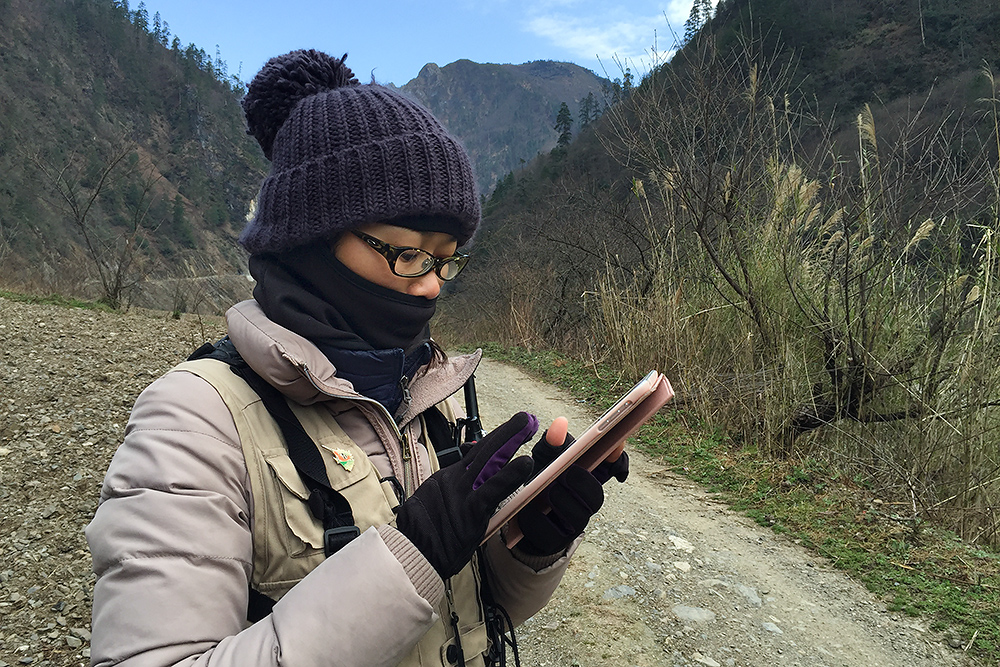
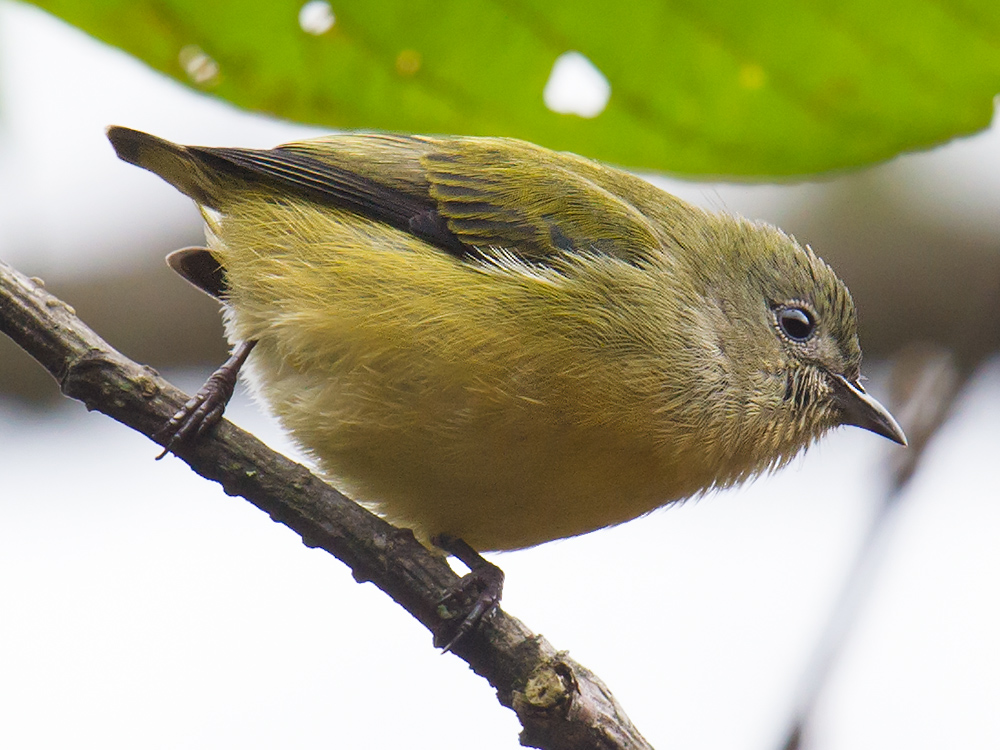
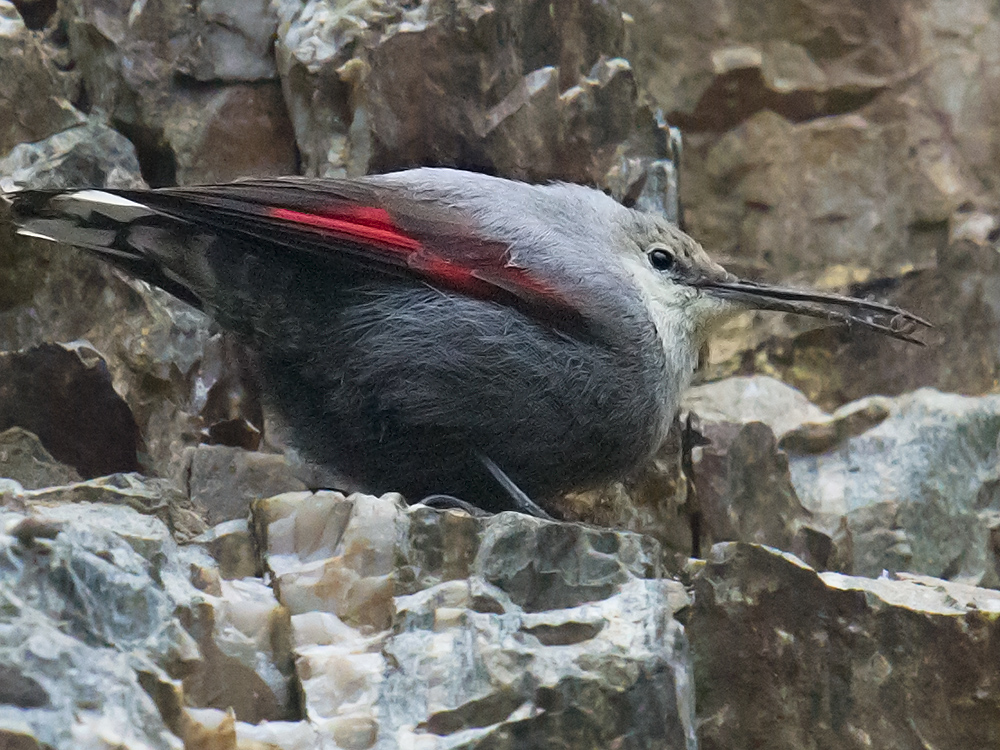
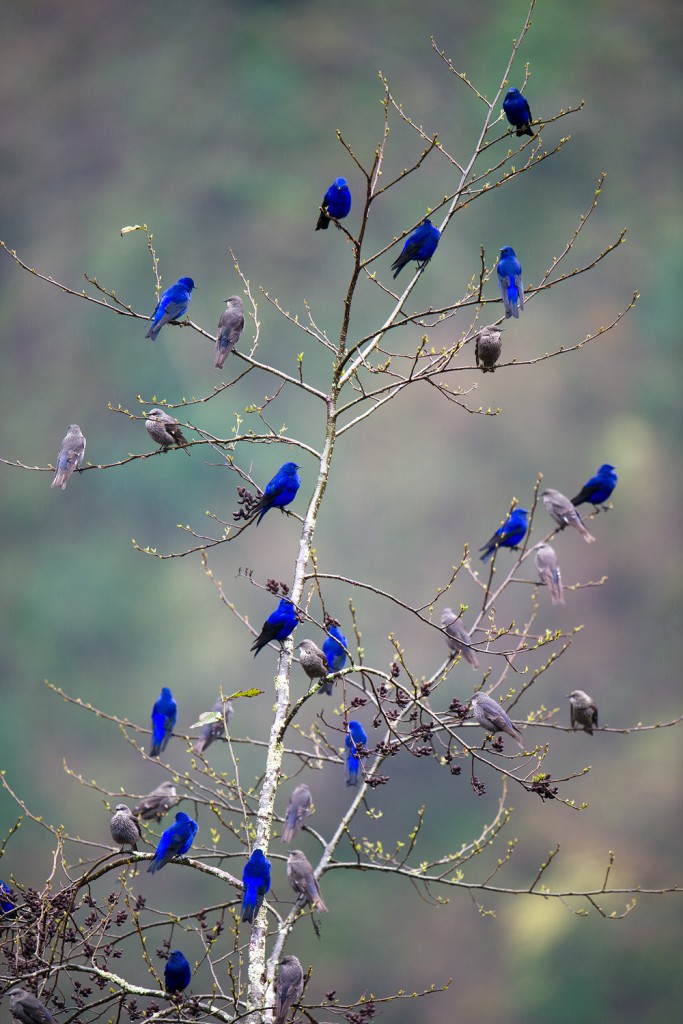
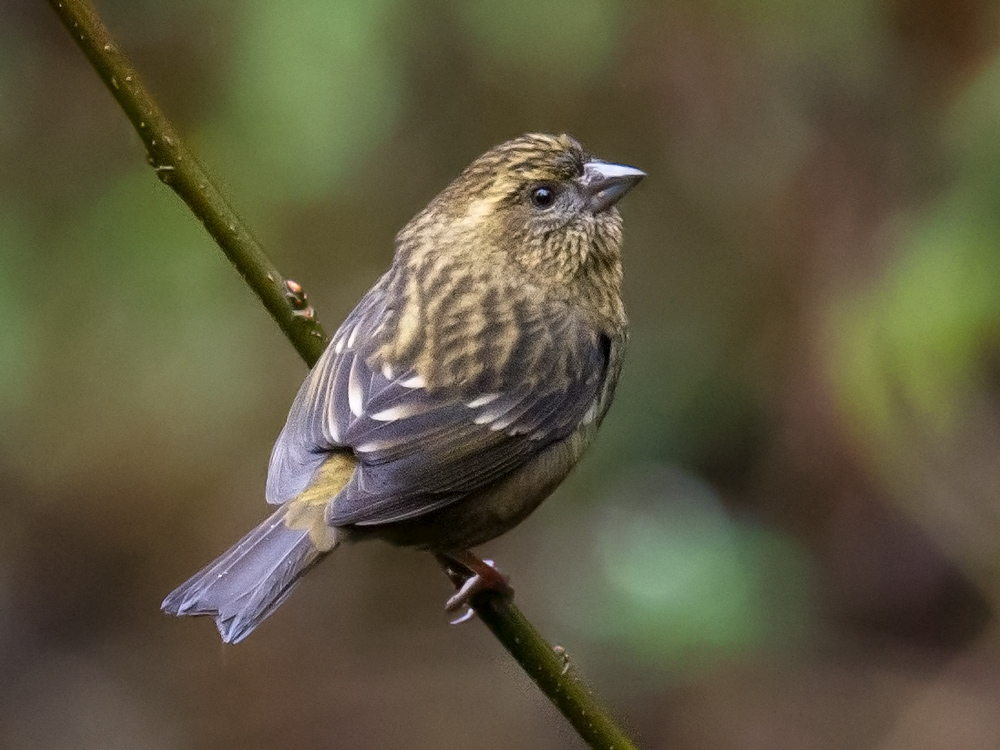
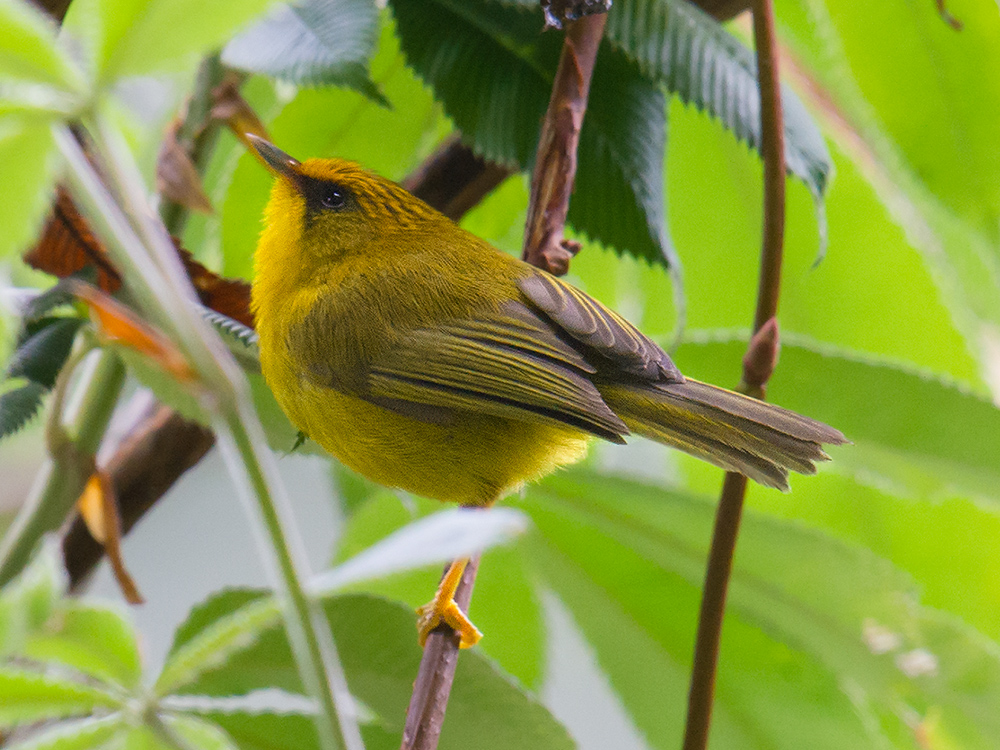
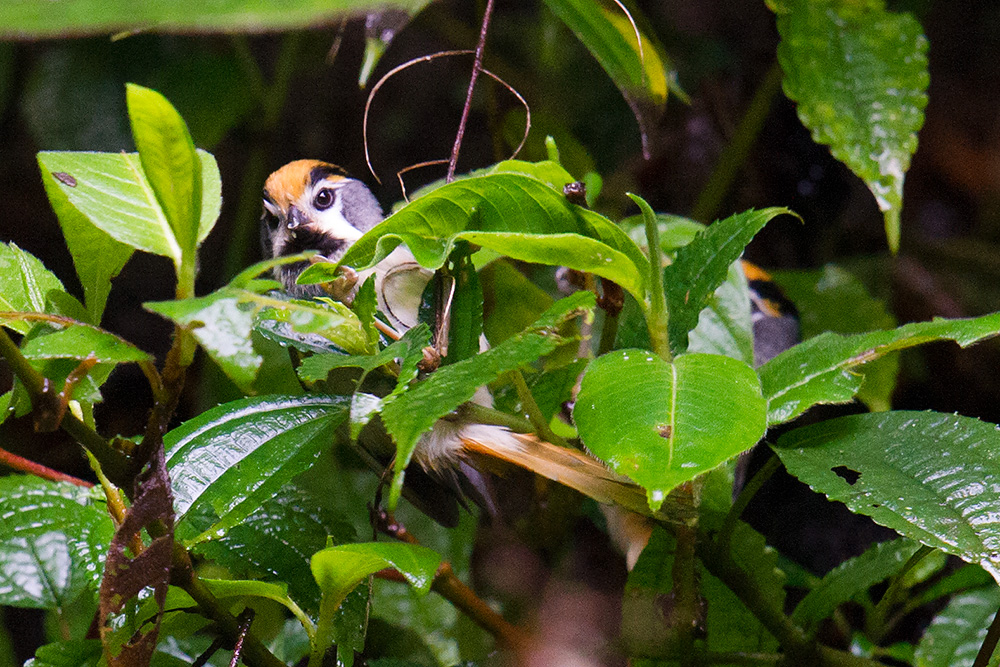
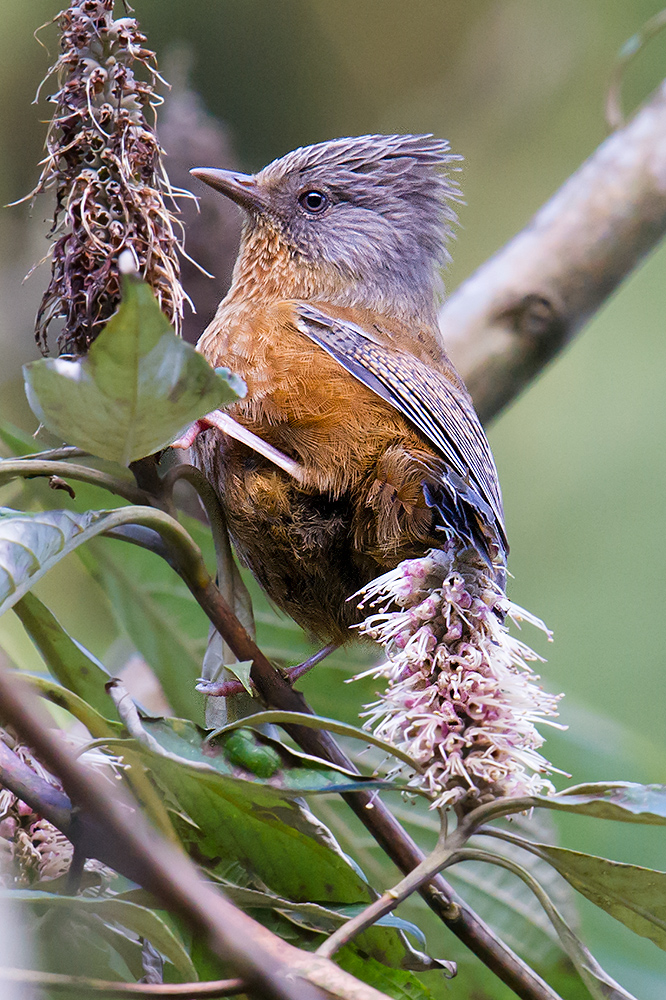
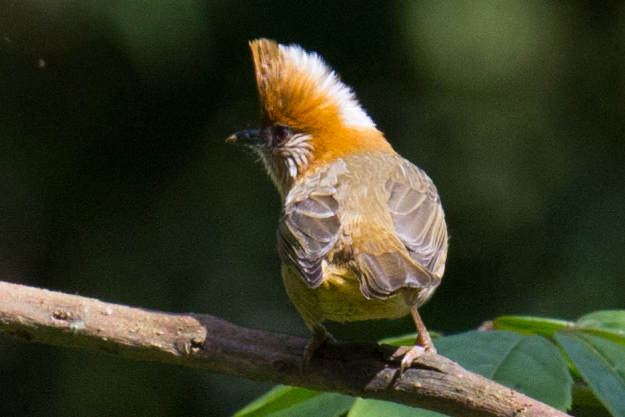
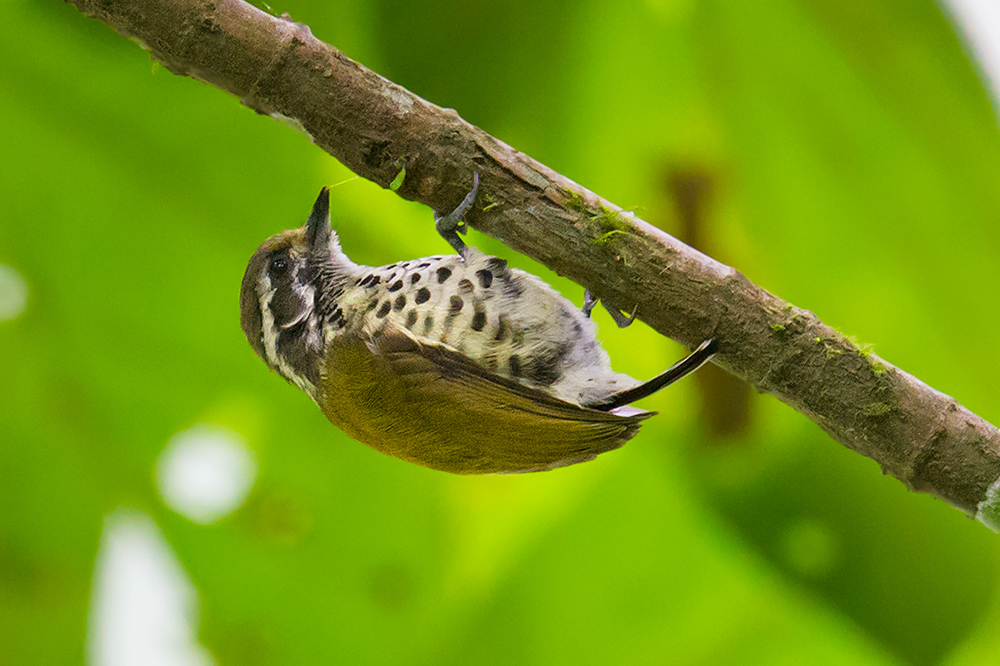
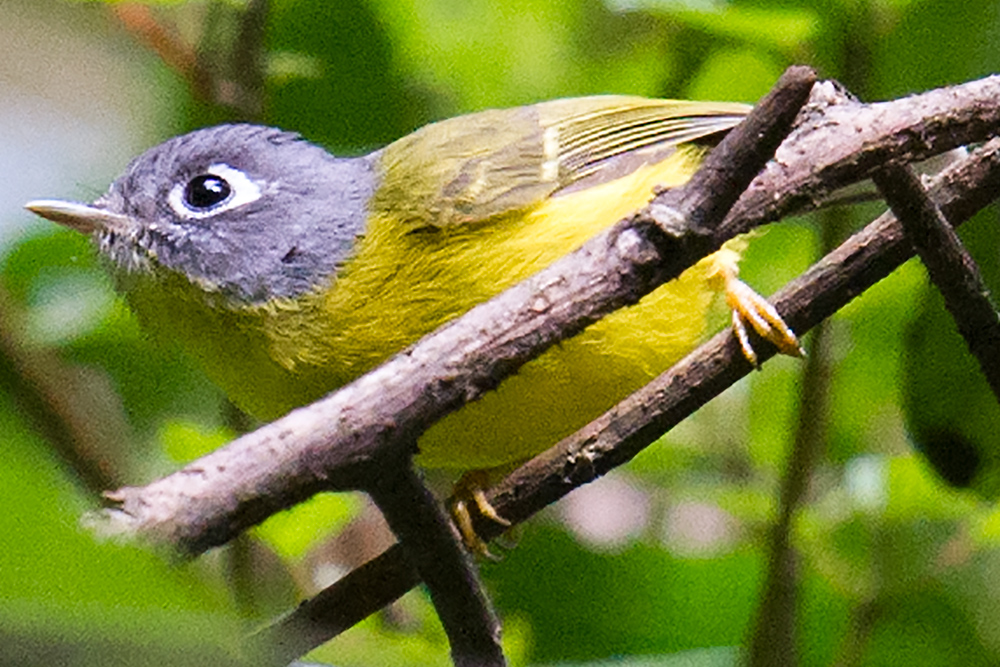
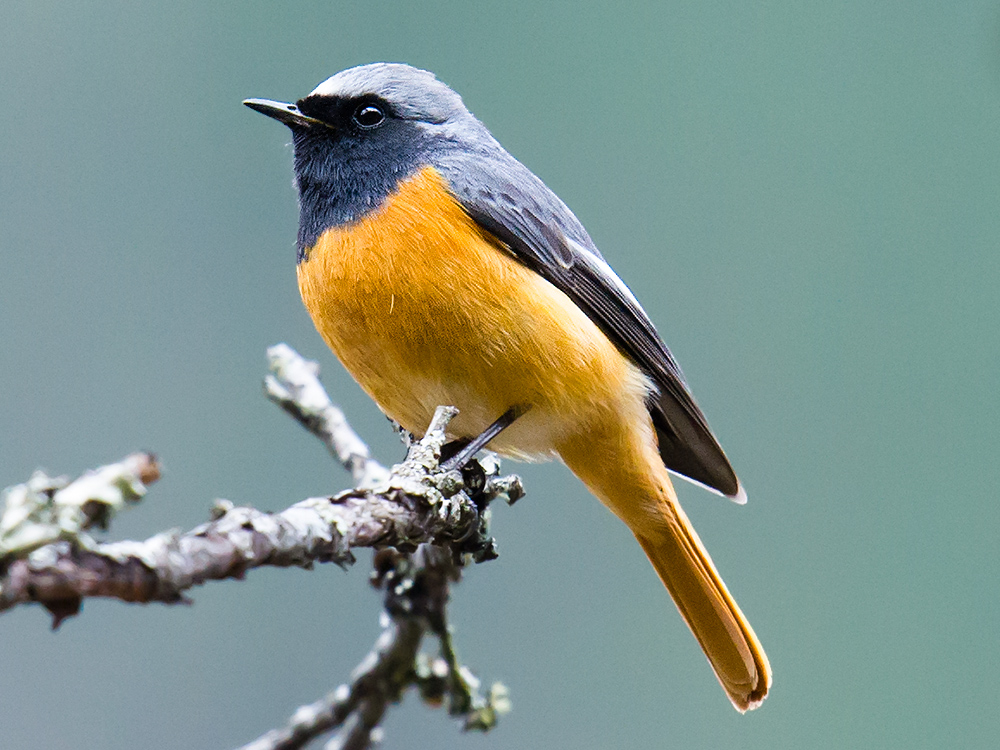
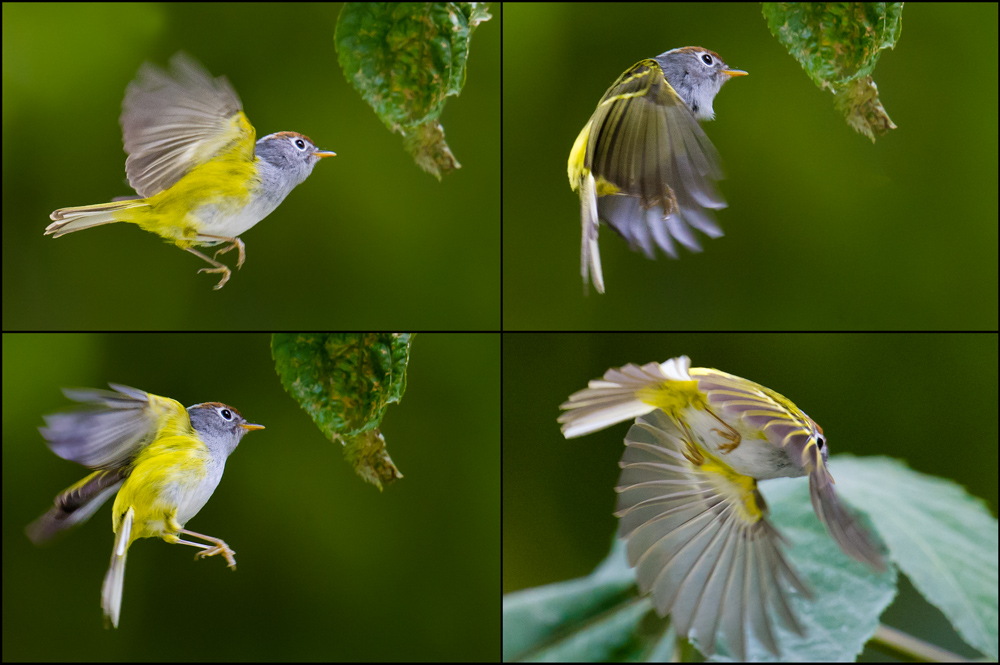
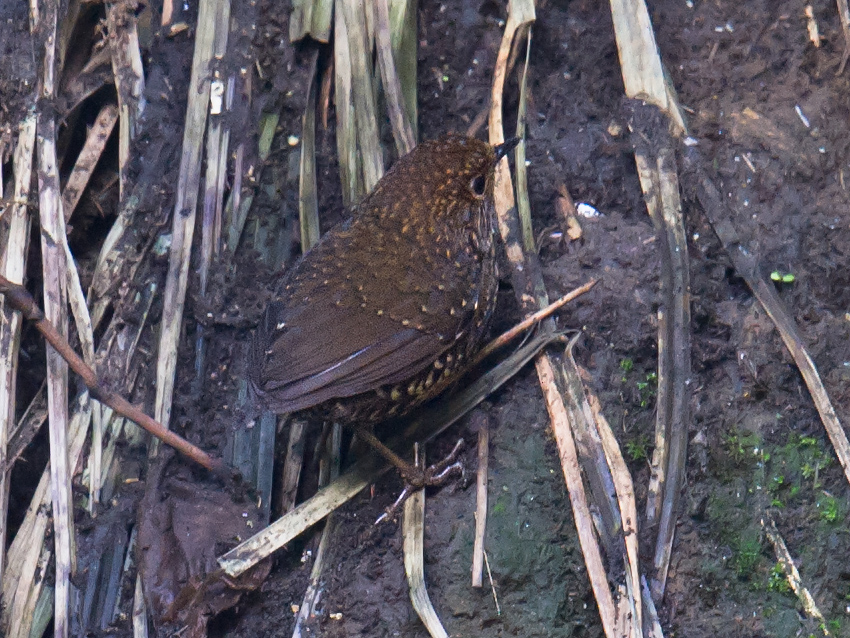
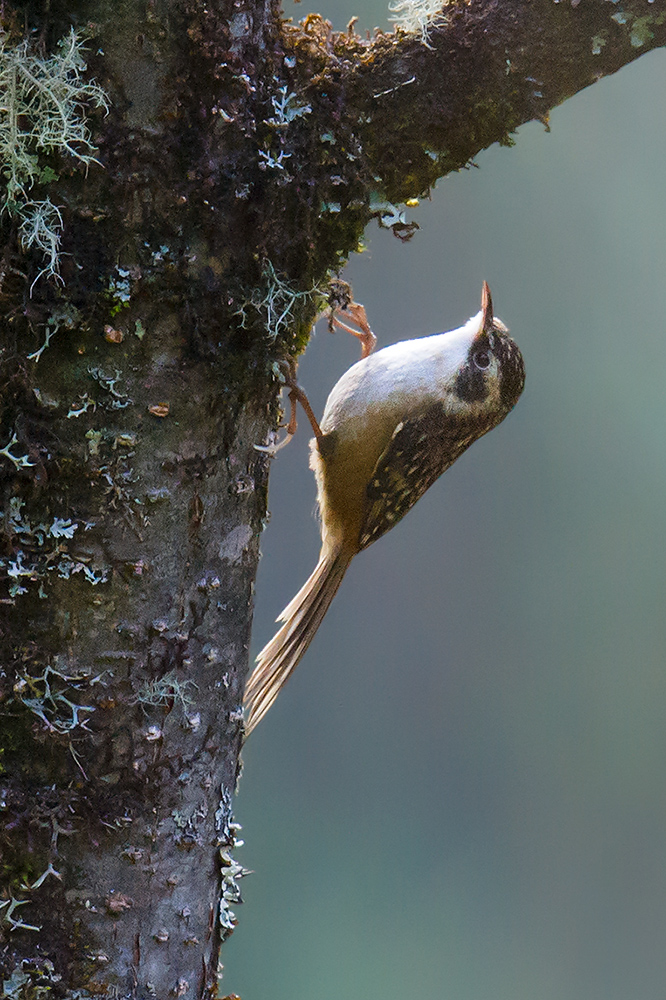
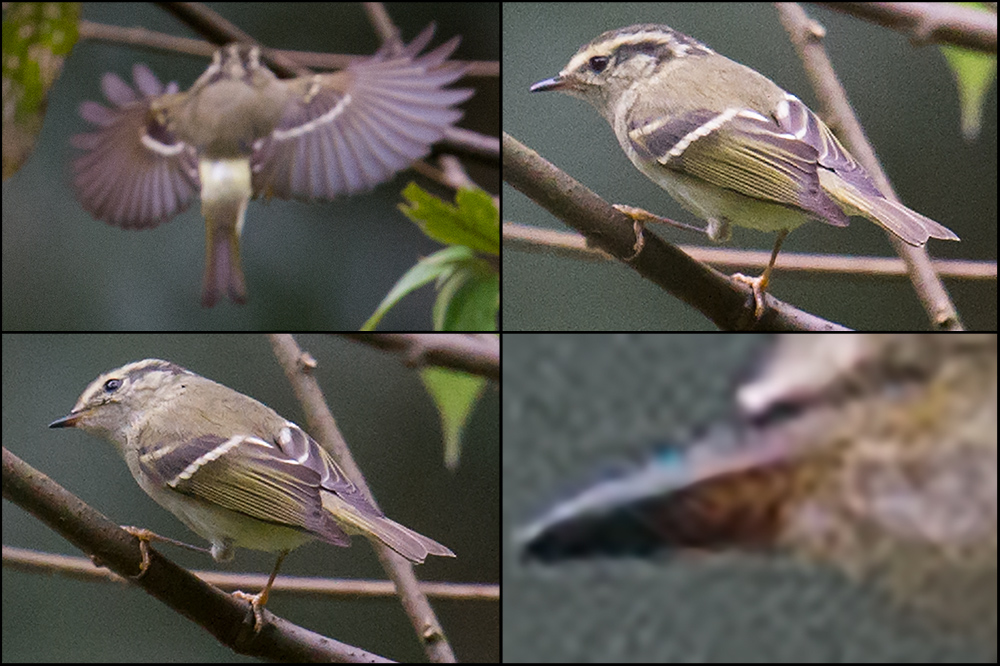
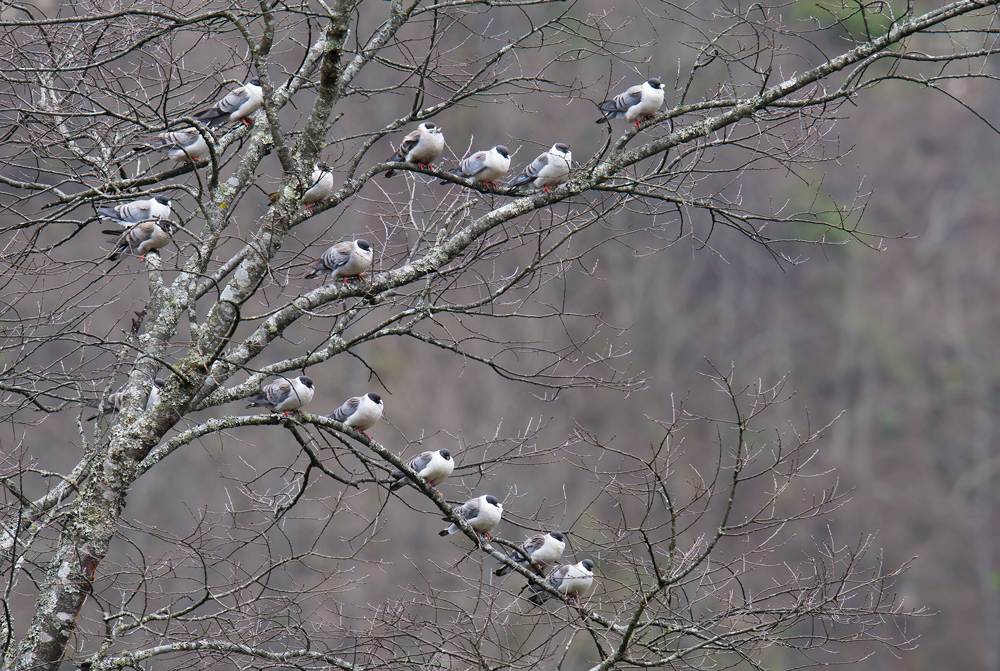


LIST OF PLACE NAMES
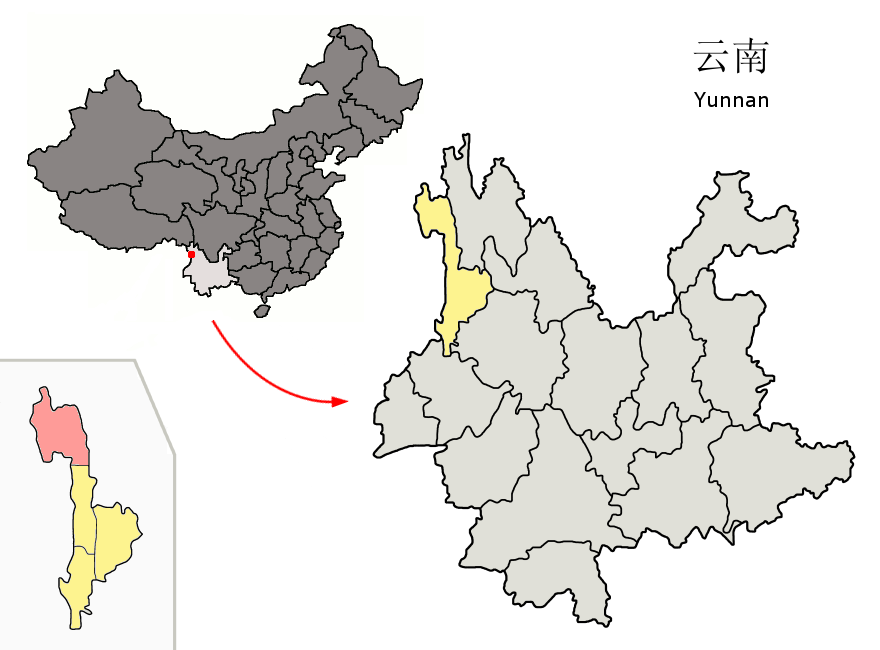
Bapo (Bāpō Xīnzhài [巴坡新寨]; 27.737042, 98.350309): village 23 km (14 mi.) S of Kongdang. Elev. 1390 m (4,560 ft.).
Dandangwang River (Dāndāngwáng Hé [担当王河]): tributary of Dulong River. Confluence at Pukawang, 4.5 km (2.8 mi.) S of Kongdang.
Dizhengdang (Dízhèngdāng [迪政当]; 28.079174, 98.325987): village Dulong Gorge 31 km (19 mi.) N of Kongdang. Elev. 1850 m (6,070 ft.).
Dulong (ethnic group): indigenous people in Dulong Gorge. Known in Chinese as Dúlóngzú (独龙族). At ca. 6,000 members, the smallest of the 56 officially recognized ethnic groups in China.
Dulong Beach (27.795076, 98.329884): birding area on scenic stretch of Dulong River 12.5 km (7.8 mi.) S of Kongdang. Elev. 1460 m (4,790 ft.).
Dulong Gorge (Dúlóng Jiāng [独龙江]): canyon Gongshan County, NW Yunnan bordering Tibet & Burma.
Dulong River (Dúlóng Jiāng [独龙江]): rises E Tibet and flows through Dulong Gorge into Burma, where it meets Mali River to form Irrawaddy River.
Dulongjiang Tunnel: part of Gongshan–Dulong Road; connects Salween & Irrawaddy basins. Elev. of E terminus: 2960 m (9,710 ft.). Elev. of W terminus: 2840 m (9,320 ft.).
Gaoligong Mountains (Gāolígòngshān [高黎贡山]): range running N-S 600 km (370 mi.) from SE Tibet into W Yunnan & adjacent Kachin State in N Burma. Divides Salween River & Irrawaddy River basins.
Gaoligongshan: see Gaoligong Mountains.
Gongshan (Gòngshān [贡山]; 27.741232, 98.665604): town NW Yunnan in Gongshan County. Also known as Cíkāi Zhèn (茨开镇). See also Gongshan County.
Gongshan County (Gòngshān Dúlóngzú Nùzú Zìzhìxiàn [贡山独龙族怒族自治县]): subdivision of Nujiang Prefecture in NW Yunnan. Contains Dulong Gorge.
Gongshan–Dulong Road: road ca. 90 km (56 mi.) connecting Gongshan & Dulong Gorge; also known as Dulong River Road (Dúlóng Jiāng Gōnglù [独龙江公路]).
Hēipǔ (黑普) Tunnel: tunnel in Gaoligong Mountains between Gongshan & Dulong Gorge. Once the main tunnel between Gongshan & Dulong Gorge; since superseded by Gaoligongshan Dulongjiang Tunnel.
Irrawaddy River: major river of Burma; a small part of Irrawaddy Basin lies in China (Dulong River).
Kongdang (Kǒngdāng Cūn [孔当村]; 27.874454, 98.336630): village Dulong Gorge 87 km (54 mi.) W of Gongshan on Gongshan–Dulong Road. Also known as Kongmu (Kǒngmù [孔目]). Elev. 1490 m (4,890 ft.).
Kunming Changshui International Airport (Kūnmíng Chángshuǐ Guójì Jīchǎng [昆明长水国际机场]; 25.101330, 102.934924): primary airport serving Kunming.
Lancang River: see Mekong River.
Maku (Mǎkù Cūn [马库村]): hamlet Dulong Gorge 37 km (23 mi.) S of Kongdang & 6 km (3.7 mi.) N of Qinlangdang. Elev. 1570 m (5,150 ft.).
Mekong River: river rising on Tibetan Plateau & flowing through Yunnan to Southeast Asia. In Yunnan often referred to as Lancang River (Láncāng Jiāng [澜沧江]).
Nujiang River: see Salween River.
Pukawang (Pǔkǎwàng [普卡旺]; (27.842608, 98.327274), resort Dulong Gorge 4.5 km (2.8 mi.) S of Kongdang. Site of confluence of Dandangwang River & Dulong River. Elev. 1480 m (4,860 ft.).
Qinlangdang (Qīnlángdāng [钦郎当]; 27.686833, 98.283097): village Dulong Gorge 43 km (27 mi.) S of Kongdang. Elev. 1220 m (4,000 ft.).
Salween River (Nùjiāng [怒江]): river rising on Tibetan Plateau, flowing through W Yunnan & into Burma.
Sibia Lane (27.909517, 98.410674): birding area on Gongshan–Dulong Road with many tall trees. So named because Beautiful Sibia are abundant there. Area extends ca. 1.5 km (1 mi.) from bridge crossing large stream E toward Dulongjiang Tunnel.
Wayaozhen (Wǎyáozhèn [瓦窑镇]; 25.445260, 99.263076), town in Baoshan, Yunnan. Elev. 1310 m (4,300 ft.).
Xiongdang (Xióngdāng Cūn [雄当村]; 28.108909, 98.322494): village Dulong Gorge 35 km (22 mi.) N of Kongdang & 4 km (2.5 mi.) N of Dizhengdang. Elev. 1850 m (6,070 ft.).
Yunnan (Yúnnán Shěng [云南省]): province SW China. Area: 394,000 sq. km (152,124 sq. mi.). Area (comparative): slightly smaller than Sweden & California; slightly larger than Japan. Pop.: 45.7 million.
BIBLIOGRAPHY
Grimmett, R., Inskipp, C. & Inskipp, T. 2011. Birds of the Indian Subcontinent. Christopher Helm, London. Behind Robson and MacKinnon, our third reference in Dulong Gorge.
MacKinnon, John & Karen Phillipps. A Field Guide to the Birds of China. Oxford University Press. Our second reference in Dulong Gorge.
Oriental Bird Club. Oriental Bird Images. orientalbirdimages.org
Robson, C. 2005. Birds of Southeast Asia. Princeton University Press, Princeton, USA. Our first reference in Dulong Gorge and elsewhere in western Yunnan.
Smith, Andrew T. and Yan Xie, eds. Mammals of China. Princeton University Press, Princeton, USA. Our first reference for mammals in China.
EQUIPMENT
Cameras: Nikon D3S; for landscapes, Apple iPad, Apple iPhone 4S, and Apple iPhone 6
Lens: Nikon VR 600mm F/4G
Sound recorder: Olympus DM-650
Binoculars: Swarovski EL 8 x 32 (Craig), Zeiss Conquest HD 8 x 42 (Elaine)
Spotting scope: Swarovski ATX-95
Tripod and head: Manfrotto 055 Carbon Fiber Tripod, Manfrotto VH502AH video head
FURTHER READING
shanghaibirding.com offers unparalleled coverage of Yunnan birding.
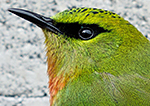
• Himalayan Thrush and Fire-tailed Myzornis in Dulong Gorge: shanghaibirding.com founder Craig Brelsford became one of the first birders to visit Dulong Gorge in northwest Yunnan. In collaboration with Per Alström, Brelsford photographed and sound-recorded Himalayan Thrush. Brelsford’s team found the exquisite Fire-tailed Myzornis as well as other species with limited ranges in China, among them Scaly Laughingthrush and Scarlet Finch.
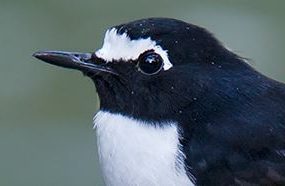
• Himalayan Specialties in the Gaoligong Mountains: This 47-day expedition included visits to Tengchong and Nabang and 25 nights at Baihualing in the Gaoligong Mountains. At Baihualing, we visited the bird-photography blinds, finding there Slender-billed Scimitar Babbler, Grey-sided Laughingthrush, and Red-tailed Laughingthrush. In Nabang on the border with Burma, we found several species whose ranges just touch China, among them Wreathed Hornbill and Black-backed Forktail.
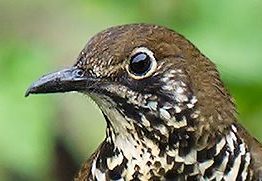
• More Detail on the Discovery of Himalayan Thrush: In collaboration with Per Alström, Craig Brelsford photographed and sound-recorded Himalayan Thrush Zoothera salimalii in the Dulong Gorge. Alström’s research led to the recognition of Himalayan Thrush as a species, and Brelsford’s photos were used in Alström’s paper and published in news outlets worldwide.
Read shanghaibirding.com contributor Mark Havenhand’s series on birding western Yunnan:
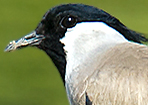
• Birding in Western Yunnan Again, I Covered Laifengshan, Hongbenghe, Shiti, and Yingjiang Wetland: After a two-year absence, Mark Havenhand returned to Yunnan, finding Wreathed Hornbill at Hongbenghe and River Lapwing at Yingjiang Wetland. One place stood out: “I loved Shiti,” writes Havenhand. “The birding there is just extraordinary … better than Baihualing and Nabang.”
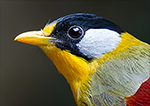
• Birding Baihualing, China’s Greatest Birding Hotspot, Amid the Pandemic: shanghaibirding.com contributor Mark Havenhand squeezed in 2½ productive days at the birders’ mecca in the Gaoligong Mountains. Havenhand noted many specialties of western Yunnan, among them Silver-eared Mesia and Flavescent Bulbul. Was a visit to the partially closed resort worth it? Click to read Havenhand’s advice.
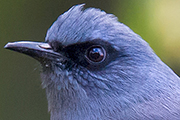
• I Birded Yunnan’s Salween Valley but Was Unable to Bird the Dulong Gorge: Stymied in his quest to bird Dulong Gorge, Mark Havenhand more than made do in the majestic Nujiang or Salween Valley, noting western Yunnan specialties Davison’s Leaf Warbler and Beautiful Sibia.

• Fire-tailed Myzornis at Pianmazhen, Near the Sino-Burmese Border in Western Yunnan: Contributor Mark Havenhand made his brief visit count, netting exhilarating views of Himalayan species Fire-tailed Myzornis plus other regional specialties such as Black-hooded Oriole. “The whole region is a paradise for the fit birder,” writes Havenhand.
Featured image: The sublime spectacle of the moon setting over the snowy Gaoligong Mountains at dawn was our reward for enduring days of rain. Photo taken on Gongshan–Dulong Road near Kongdang on 26 Feb. Nikon D3S, 600 mm, F/9, 1/320, ISO 640. (Craig Brelsford)
Systematic List of Birds Noted
Go to Explorations page

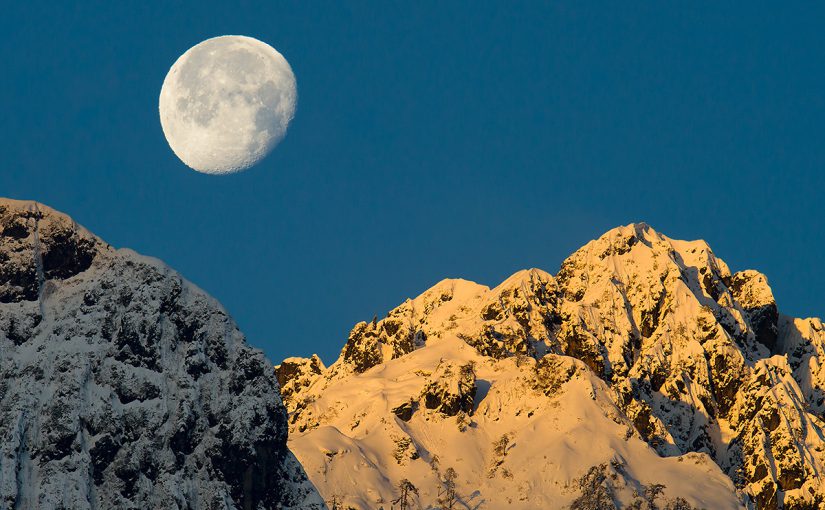
Many fabulous birds – congratulations to you all. Congrats on the Gongshan Muntjac.
It looks like the government has spent a lot of money improving the look of Kongdang, as well as the roads.
Hi John, Our impression is that the government is placing a big bet on tourism taking off in Dulong. The bet may or may not pay off. Because the area is so rugged, it’s doubtful that any highway wider than the two-lane S228 will ever be built in the Salween Gorge. It’s also doubtful that airports could be built around there. Therefore, only motivated tourists will brave the long, tricky drive to Dulong.
Wow! Absolutely amazing your adventures, Craig!
What spectacular photos! Wondrous!
Hi Craig, nice list. We also saw Gongshan Munjac on the access road fairly easily but at night. Jonathan
Dear Craig,
I am working on revision of the Rattus pyctoris complex and found your note about one dead individual you found on the road between Gongshan-Dulong riv. Do you have a photo of this individual by any chance? The presence of R. pyctoris in China is disputable and a photo would shed light on this issue.
Thanks,
Glib
2022 update – all tourists are banned from Dulong Valley since 9 months due to pandemic control. There is a checkpoint at HeiWaDi approx 20km from Gongshan
Dear Mr. Brelsford,
i have seen your nice Pictures of GRANDALA at the Internet.
How can i get These Pictures for My private use – as electronic ones or just paper print?
I’d like to hang them in My private Office.
Thank you for your Reply,
Have a good start in 2023.
Best regards
Jürgen Hörr
Dear Jürgen, thanks for your interest in
my photographs. shanghaibirding.com does very much license photos for a fee. I’ll reach you privately with price and terms.
I’m Publishing Editor at Springer, where I’m responsible for the book program in the field of zoology.
We are currently working on the book “The Deer of the World – Ecology, Conservation and Management” (edited by Mario Melletti and Stefano Focardi) and I would like to ask you if we can use your photo(s) of Muntiacus gongshanensis (Gongshan Muntjac) from your Shanghaibirding website in the book (https://www.shanghaibirding.com/tag/gongshan-muntjac/page/2/). Of course, you will be indicated as photographer in the figure legend and Copyright owner.
Thanks in advance. I very much look forward to hearing from you soon.
Best regards,
Dr. Lars Koerner
Senior Editor
Animal Sciences
Springer
Heidelberg, Germany
Just come back from a trip to the Dulong valley, which is open to tourists in January 2024. There are passenger vans (100RMB per person) that run from the centre of Gongshan to Dulong town, leaving at 11am daily and taking about 3 hours (the road is currently only open from 11.30 for a few hours daily to enable further upgrading work to be done).
I stayed at the Hapang Pubu in Dulong township for about 200 yuan a night. The friendly staff can arrange for a driver to take you on day tours up and down the valley for about 700 RMB/vehicle/day. I had a great guide who took me on the epic trip down the canyon to Maku, the last town at the Burma border, where there is a scenic waterfall and some guesthouses (but no Burmese people, the border is totally sealed off, like a modern day Iron Curtain).
I also visited the north of the valley, which is much colder and sparsely forested, more similar to a Tibetan landscape, as the road eventually continues into Tibet. I went as far north as Xiongdang, and beyond to the new ‘tourist theme village’ Kelaluo where there are new guesthouses and a water feature – not too remote any more.
Dulong is now easily accessible from Kunming via Baoshan (3 hour high speed train) then a 4 hour bus to Gongshan. No special permits needed and no police hassles except for a universal document inspection when entering the Nujiang at Liuku.
Thanks for the update.
Thanks a lot for sharing those amazing pictures and the super useful information!
My friend and I plan to join a self-driving trip form Lijiang-Dali-Chuxiong-Dulong Gorge. He is a Swedish with a tourism visa and the rest of us are native Chinese. As far as we know, we might need to book the ‘foreign-related’ hotels. But what I am worried about is that if there are any restrictions to entering Dulong Gorge now. The blog was written in 2016 and another blog mentioned that Dulong Gorge was unavailable during the ‘pandemic’. But since China is open again, is it possible to visit there now?
Dear Wenjia, thanks for reaching us, and best wishes on your trip. Please see Michael Woodhead’s comment above.